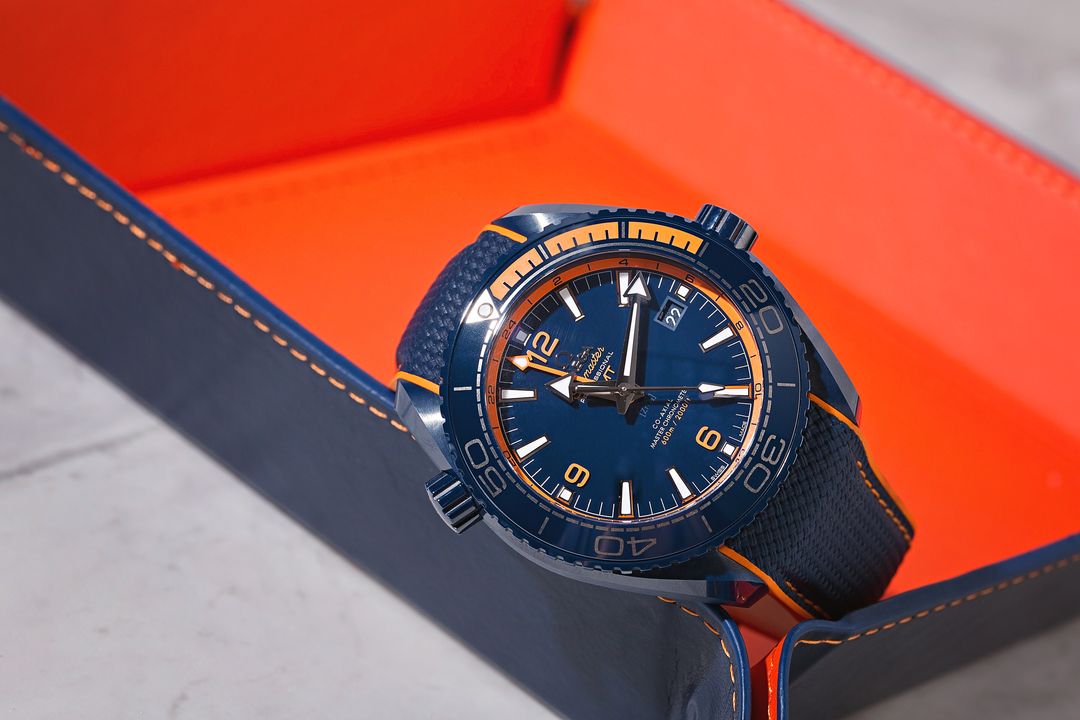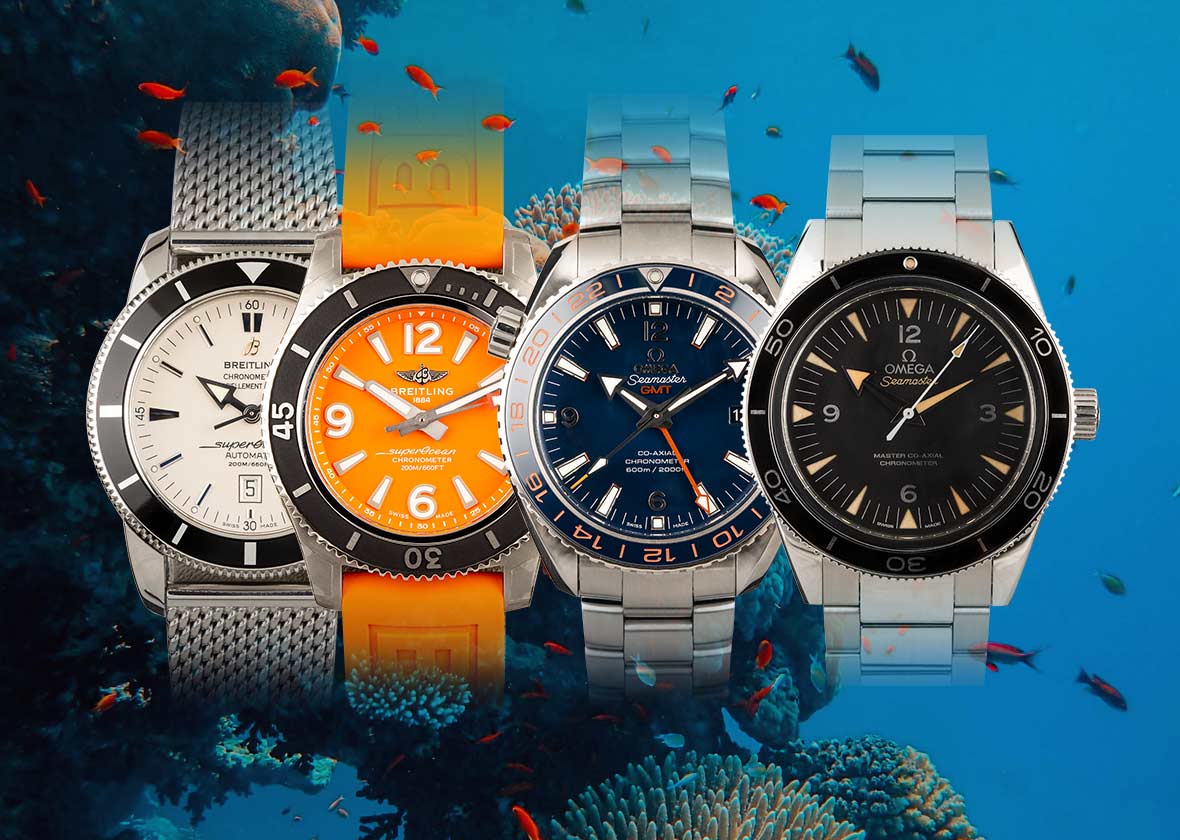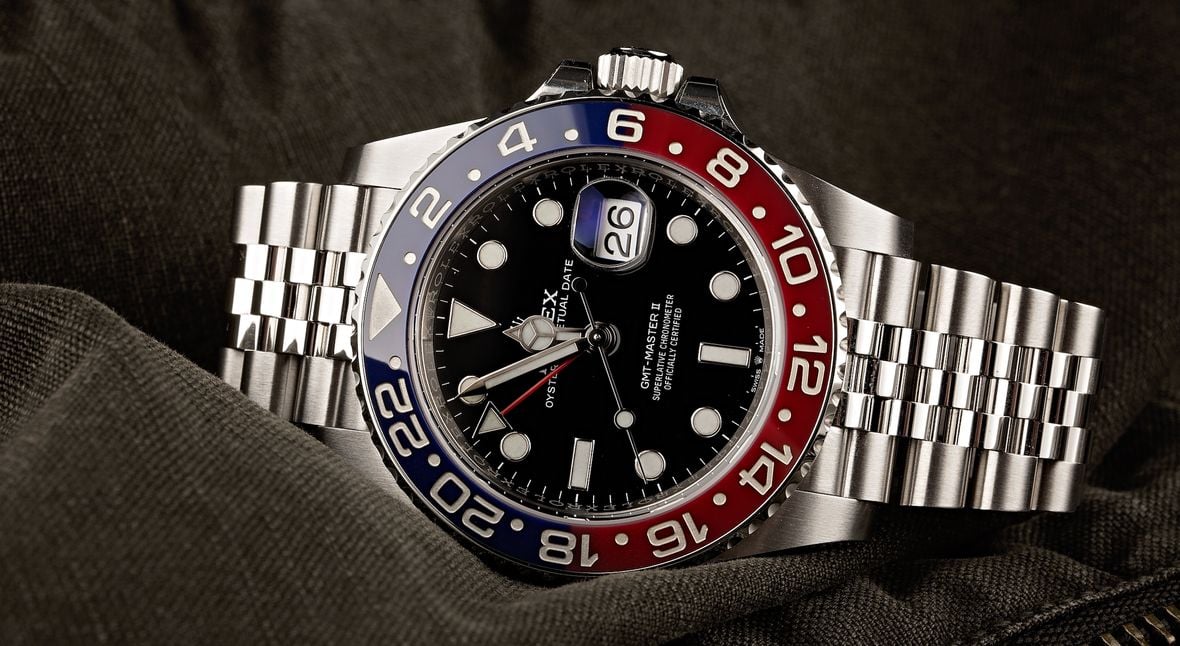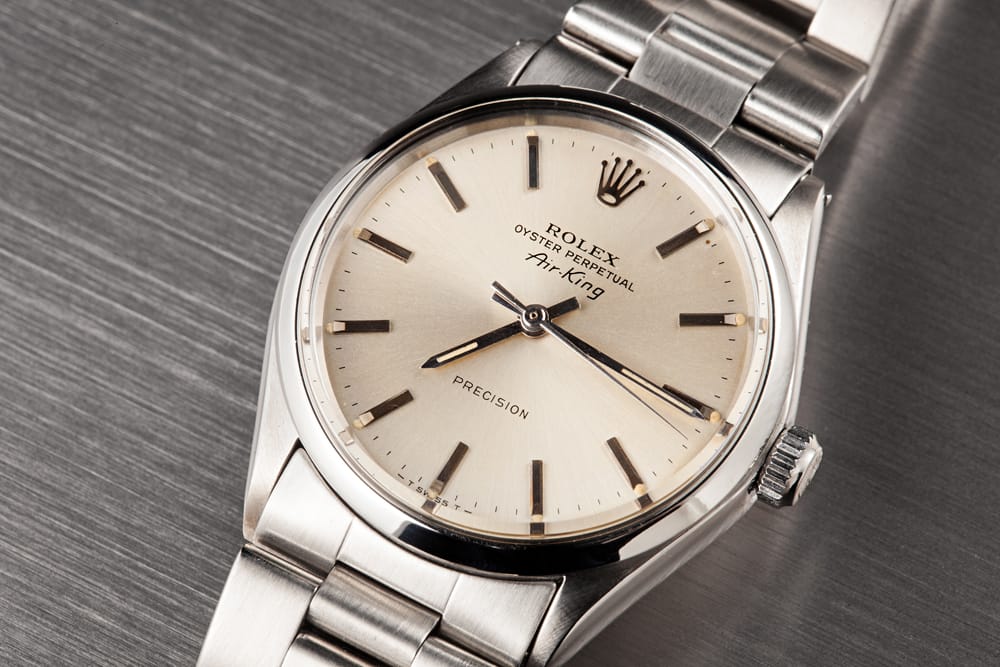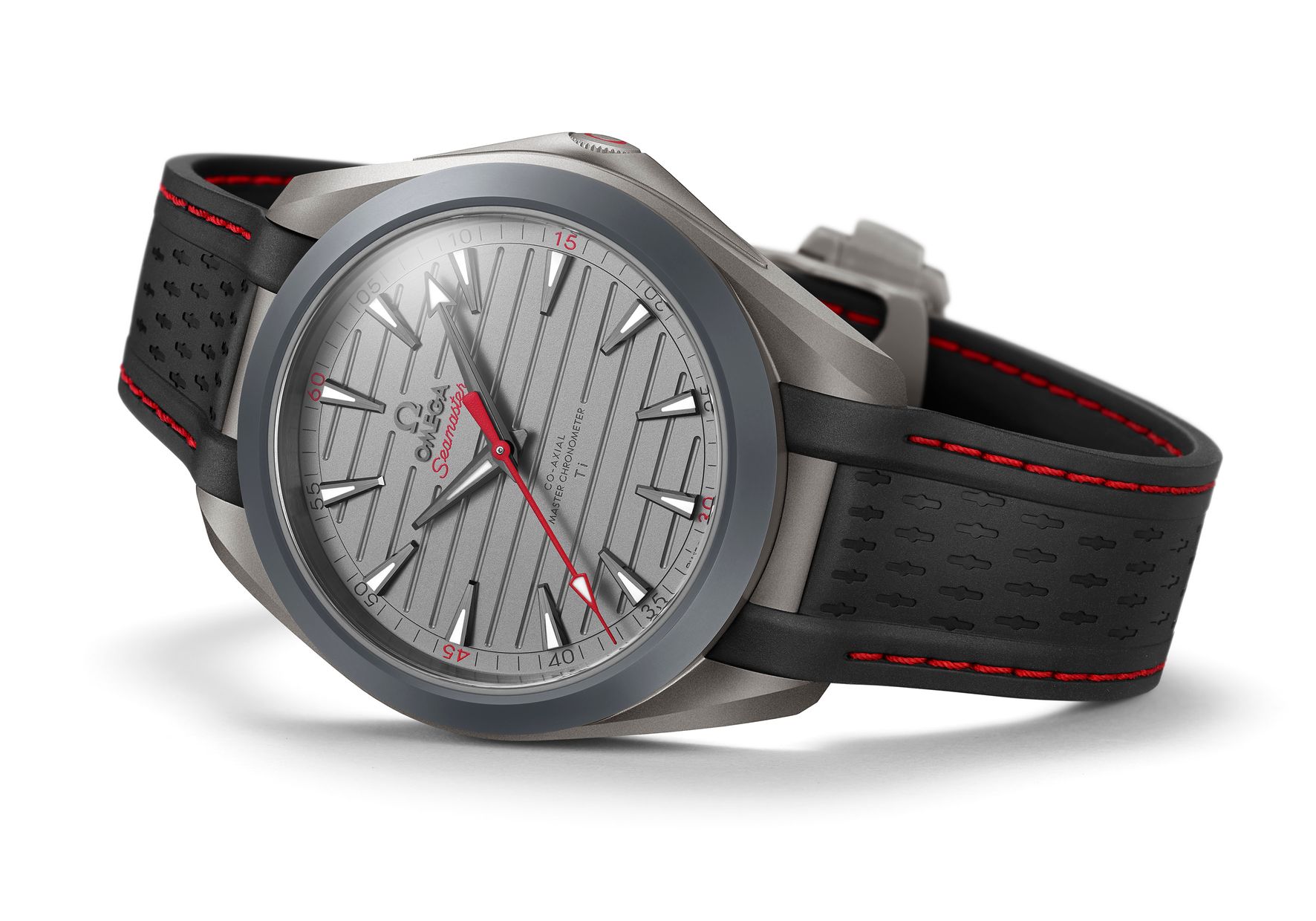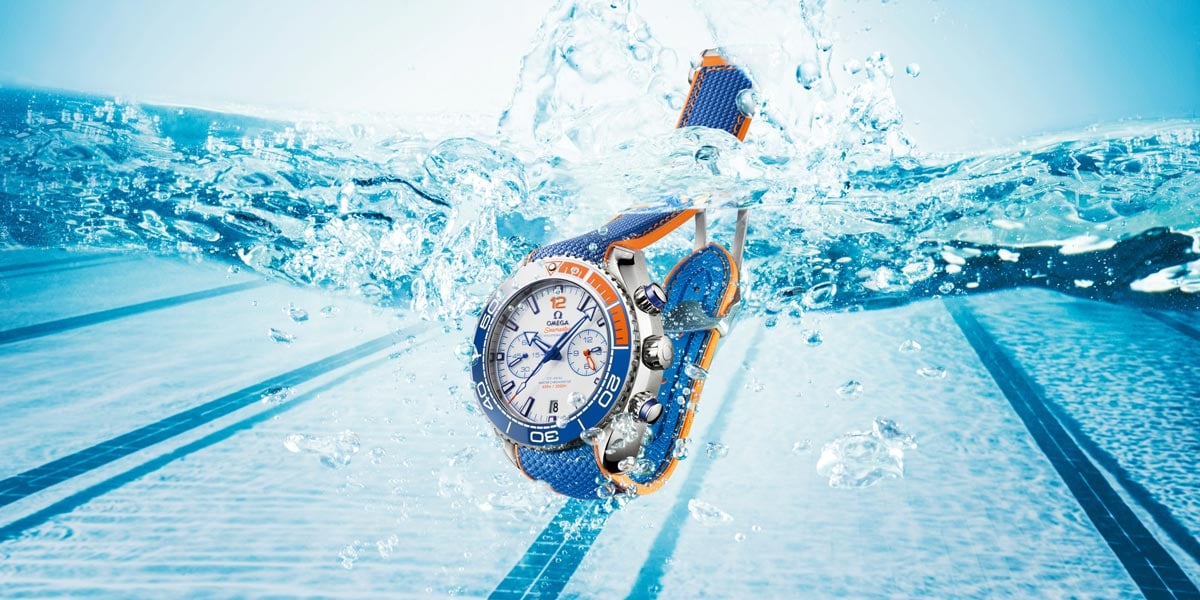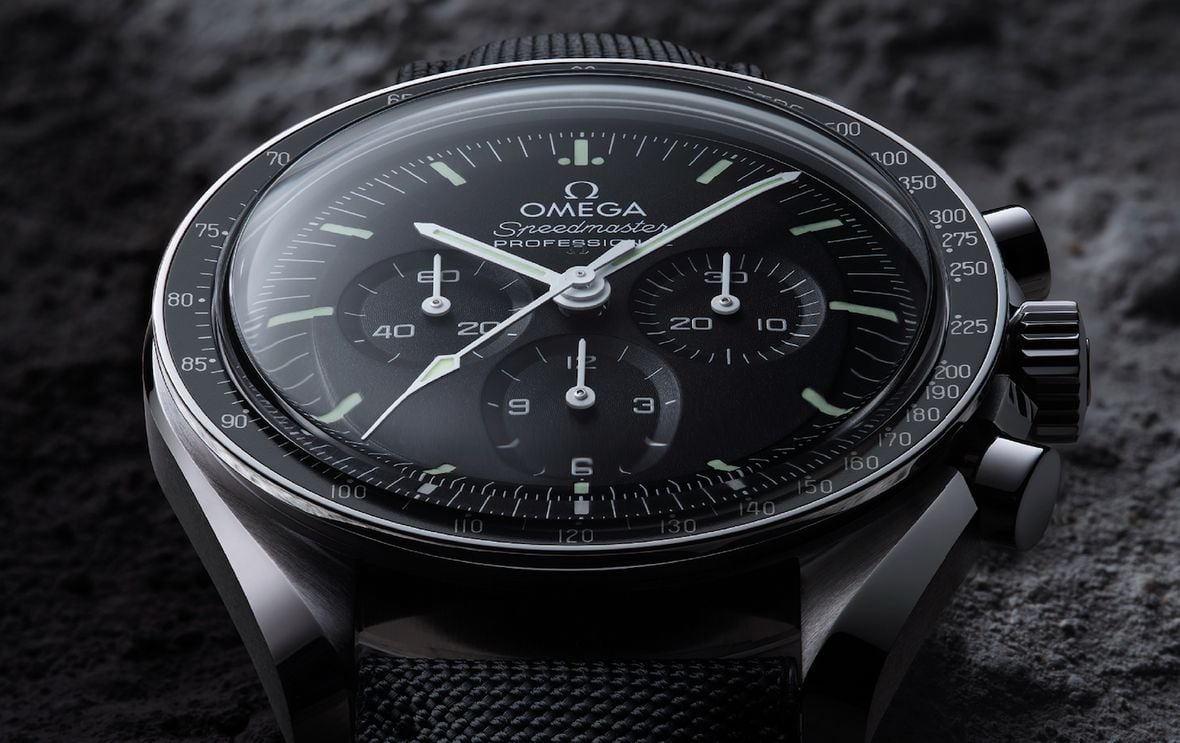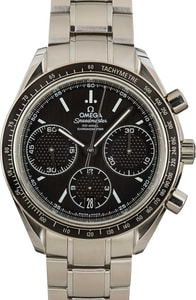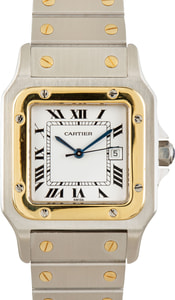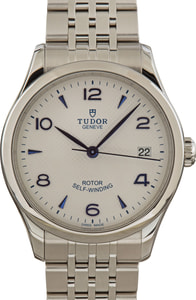A Breitling versus Omega head-to-head is not one that comes up as often as you might imagine. For most of their respective histories, the brands have occupied two different spheres of the same Venn diagram, rarely overlapping in factors such as styling, price, or functionality.
However, both brands do produce extensive lines of water-resistant sports watches, but what are those models? Breitling’s dive watch category is currently divided between the contemporary Superocean and the neo-vintage Superocean Heritage II. On the other hand, Omega’s collection of professional divers is contained within one category, the Seamaster, of which there are numerous sub-models. Those include the Planet Ocean, Aqua Terra, and Railmaster, just to name a few. It’s also worth noting that both brands also offer wildly successful vintage-inspired divers, complicating matters even further.
This comparison guide ultimately aims to answer the question, what is the difference between the Seamaster and Superocean? As you will soon find out, most of it boils down to aesthetic differences characteristic of each brand and price point. Join us as we break it down as best we can to determine which watch belongs on your wrist, the Breitling Superocean? Or the Omega Seamaster?
Breitling vs. Omega
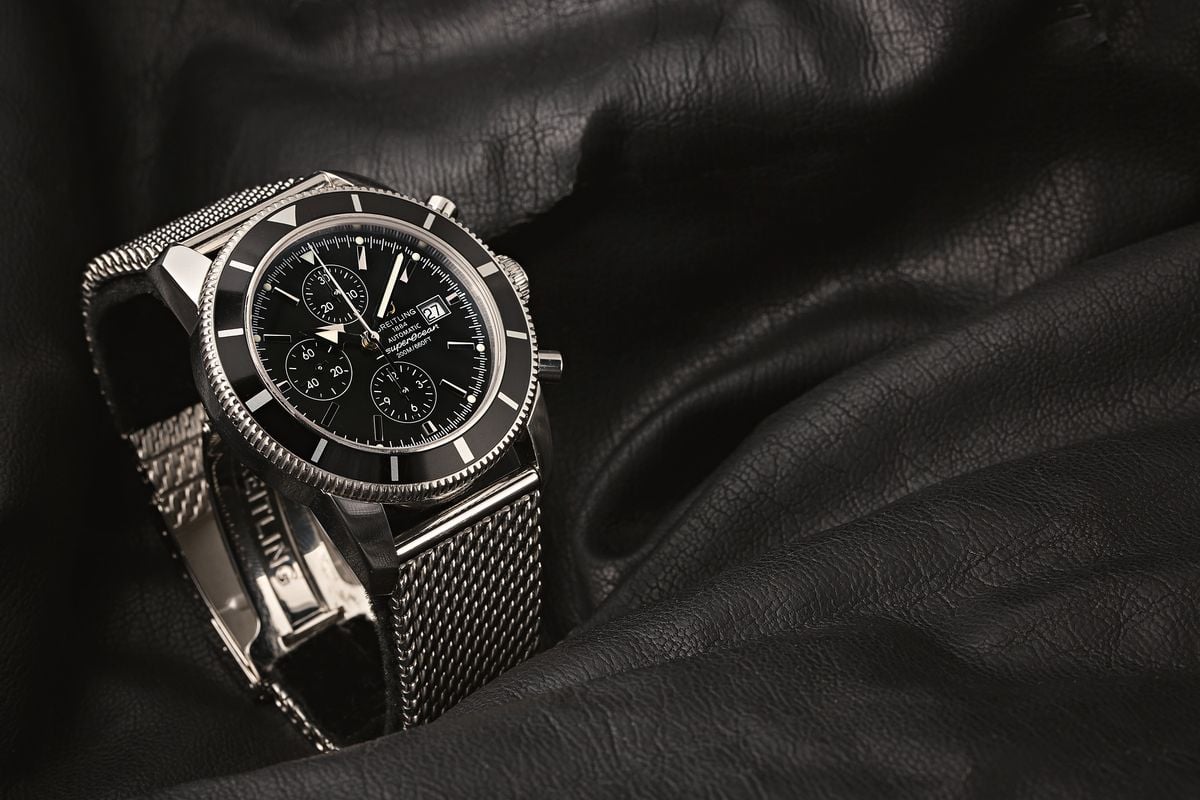
Traditionally, Omega has been seen as a level above Breitling in the luxury watch hierarchy, although at least some of it could be attributed to marketing. While the latter company has produced a number of breakthroughs and culturally significant pieces through the years, it is Omega which is usually the ‘other’ brand non-watch enthusiasts will have heard of (the first obviously being Rolex). Much of that recognition hinges on the priceless advertising of stepping onto the moon, and a lot more comes from being the current manufacturer of choice for James Bond.
Breitling has started to majorly expand its global reach since Georges Kern arrived at the company as the new CEO in 2017. The once somewhat scattergun catalog of watches he inherited has been ruthlessly streamlined by dividing the whole thing up into three main categories – land, sea and air – in an effort to try and build its customer base beyond just the aviation-obsessed. Kern has also taken a cue from the fashion du jour of directing his sights back into the archives, identifying classic favorites and reissuing them with a 21st-century twist.
As for Omega, it too has been working hard to simplify its output, although for a number of years now. The 1970s and 80s were a tough time for the brand, and its response to the quartz crisis was to jump on every fad and bandwagon that rolled its way. It resulted in the creation of some relatively unorthodox models, many of which were made part of the brand’s two most famous families; the Speedmaster and Seamaster. As a result, the collections became rather diluted, and all the confusion is only now finding some semblance of order and consistency.
Arguably to an even greater degree than Breitling, Omega has not been shy about opening up the vaults and drawing inspiration from past glories – and many of those models are very glorious indeed. On paper, the two brands seem to be fairly well matched. However, what happens when we get their respective dive watch collections into a standoff?
Breitling’s range is split down the middle, between the thoroughly modern Superocean and the vintage-inspired Superocean Heritage II series. As for the Omega Seamaster, that name still encompasses a colossal number of different types including the Planet Ocean, Aqua Terra, and contemporary Railmaster models.
Below, we are going to explore the two brand’s offerings for underwater adventurers and (as much as possible) compare them like for like.
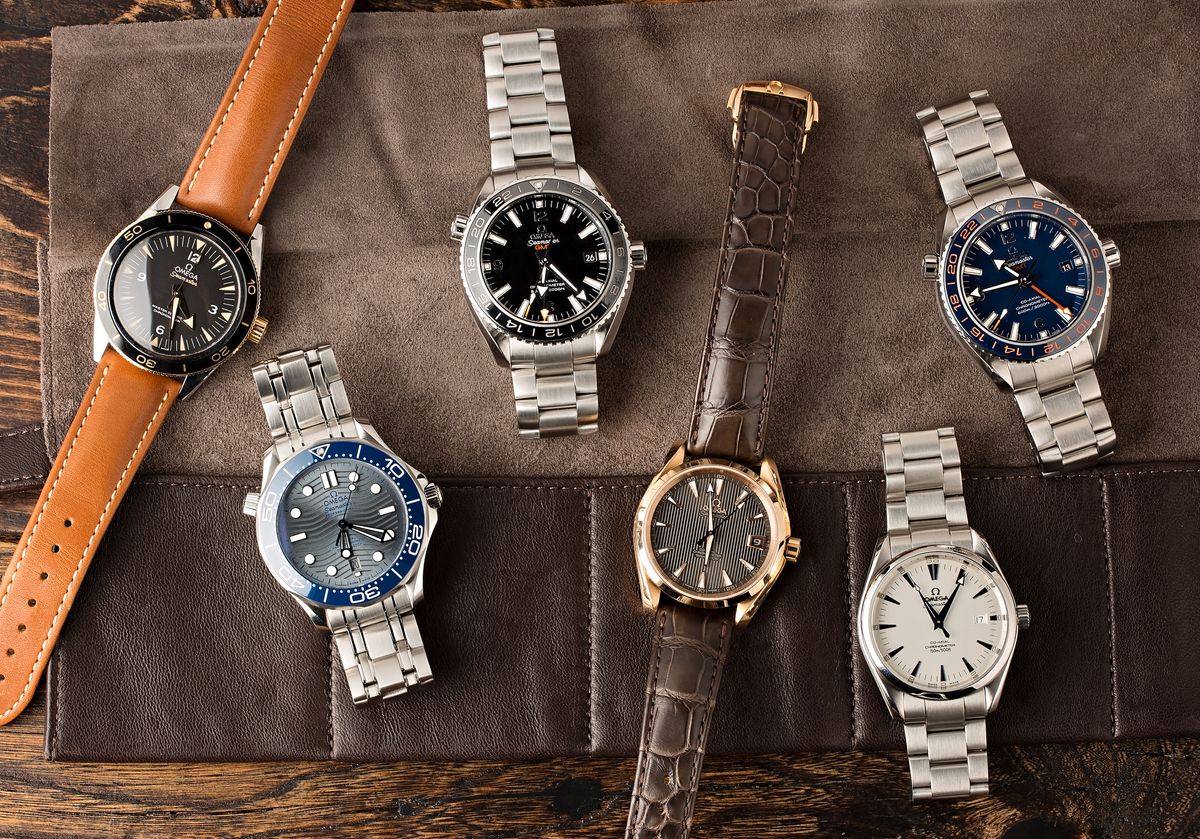
A Little History
Breitling
One thing both watchmakers can safely claim is a highly impressive legacy. Founded in 1884, Breitling came into being at a time of incredible progress in all forms of technology, continuing on from the Industrial Revolution. After modest beginnings, the brand started to expand in both scope and ambition; however, it wouldn’t truly come of age until WWI.
The first conflict to witness aerial combat, the war led to a massive expansion in aviation and, consequently, the need for high precision pilot’s watches. Breitling’s owner, Gaston Breitling (the son of founder Léon Breitling) shifted his workshop’s focus towards creating timepieces for this new breed of flyer and in 1915, the company unveiled the first-ever chronograph wristwatch with an independent pusher. The invention, which separated the start and stop function of the chrono, proved a major boon for aviators and allowed them an easier and more accurate way of keeping track of flight times.
From then on, the brand’s name would be unequivocally linked to the skies – and to chronographs in particular, with perhaps their greatest achievement encompassing both fields being the iconic Navitimer. Over the years, Breitling has partnered with the British RAF and the U.S. Army, and while the brand can’t claim the moon as Omega can, it was a Breitling that would be the first worn in space by an American. Lt. Commander Scott Carpenter, one of the original Mercury 7 astronauts, orbited the Earth three times with a modified version of the Navitimer (called the Cosmonaute) on his wrist.
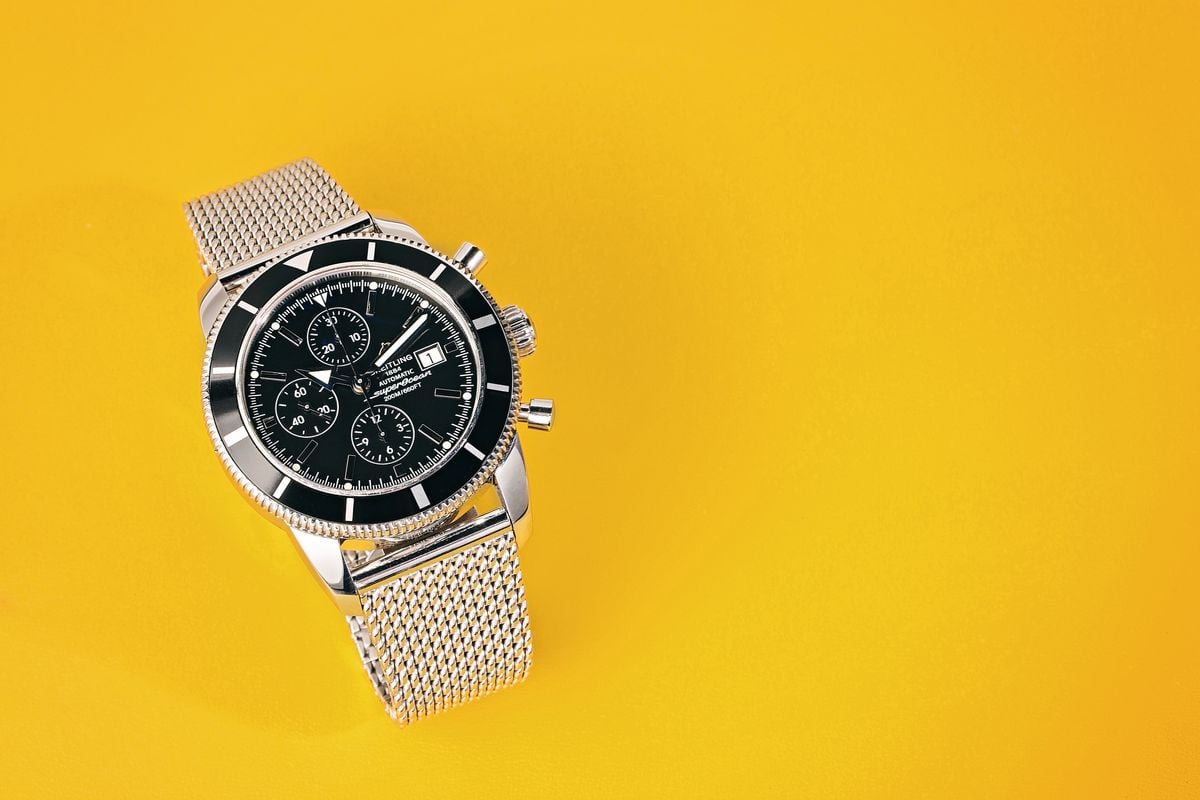
From the Skies to the Sea
Breitling’s litany of successes with pilot’s watches and chronographs has sometimes overshadowed its dive watches. However, the release of the first of the Superocean collection in 1957 saw Breitling more than hold its own against three of the biggest and most famous examples of the genre: the Rolex Submariner, the Blancpain Fifty-Fathoms, and the Omega Seamaster.
Far from simply making up the numbers, the two 39mm Superocean models (the ref. 1004 time-only variant and the ref. 807 chronograph) were highly capable performers in their own right, their 200m water resistance matching Rolex and Omega and doubling the depth rating offered by Blancpain. In addition, the cleanliness of Breitling’s designs meant they were both extremely practical in terms of legibility as well as being aesthetically accomplished.
Breitling’s Superocean watches continued to be updated and fine-tuned over the subsequent decades, becoming even more adept with the incorporation of helium escape valves and thicker cases. Today, the hardiest examples are rated down to an incredible 2,000 meters and represent the pinnacle of the modern luxury dive watch.
In 2007, the original models celebrated their half-century and Breitling marked the occasion with a reissue of the debut reference 807, dubbed the Superocean Heritage. While not an exact carbon copy, it was pretty close, with its large sword hands and braided steel bracelet. The 1950s Flying ‘B’ logo and ‘Superocean’ script were also both reinstated, adding up to more of an affectionate nod to past glories rather than an all-out, over-the-top duplicate.
That version was itself superseded in 2017 (on the inaugural model’s 60th birthday) by the Superocean Heritage II. With far more similarities than differences to the original Heritage, this second generation is most easily identified by the slightly revamped handset and the inclusion of an ultra hard-wearing ceramic bezel. Inside the three-handed models though, lies the Tudor-built Cal. MT5612 (branded as the Breitling B02 movement), taking over from the previous ETA-based 2824-2. It signified a major collaboration between the two brands, with Tudor receiving the Breitling B01 chronograph movement in return for use in its Heritage Black Bay Chrono.
The Breitling Superocean Heritage II series now consists of some 30 different models, across a range of sizes, metals, and colors. They have been an enormous success for the manufacturer and are arguably one of the best heritage-inspired dive watches that have been circulating the industry in recent years. As for the Superocean collection, that too has been an impressive performer in terms of sales and it has even been opened up to a unisex audience, something that would have been flat-out unthinkable just a few short years ago.

Omega
The Seamaster is Omega’s longest-running name; there has been a model with the title in the brand’s catalog ever since 1948. That year was also the company’s 100th anniversary and the original Seamaster was created as Omega’s congratulatory pat on the back to itself for reaching a century in business. However, that piece was a simple three-handed dress watch, the only thing earning it the ‘Seamaster’ name being the rubber gaskets for the crown and case back (rather than the previous lead or shellac type) that improved its water resistance.
The debut Seamaster in its true dive watch form came along in 1957 as one-third of the company’s ‘Professional Collection’. Officially called the Omega Seamaster 300 (although it was only water-resistant to 200 meters), the CK2913 lined up alongside the CK2914 Railmaster (an antimagnetic model designed to do battle against the Rolex Milgauss and IWC Ingenieur) and the CK2915 Speedmaster, the legendary and soon-to-be-moon-bound chronograph.
From the outset, the Omega Seamaster has taken aim at the same summit as the Rolex Submariner, both vying for the title of being the world’s favorite dive watch. It is a fracas that still continues today, in much the same way that collectors continue to debate as to whether the Speedmaster or the Daytona is the greatest racer’s chronograph of all time.
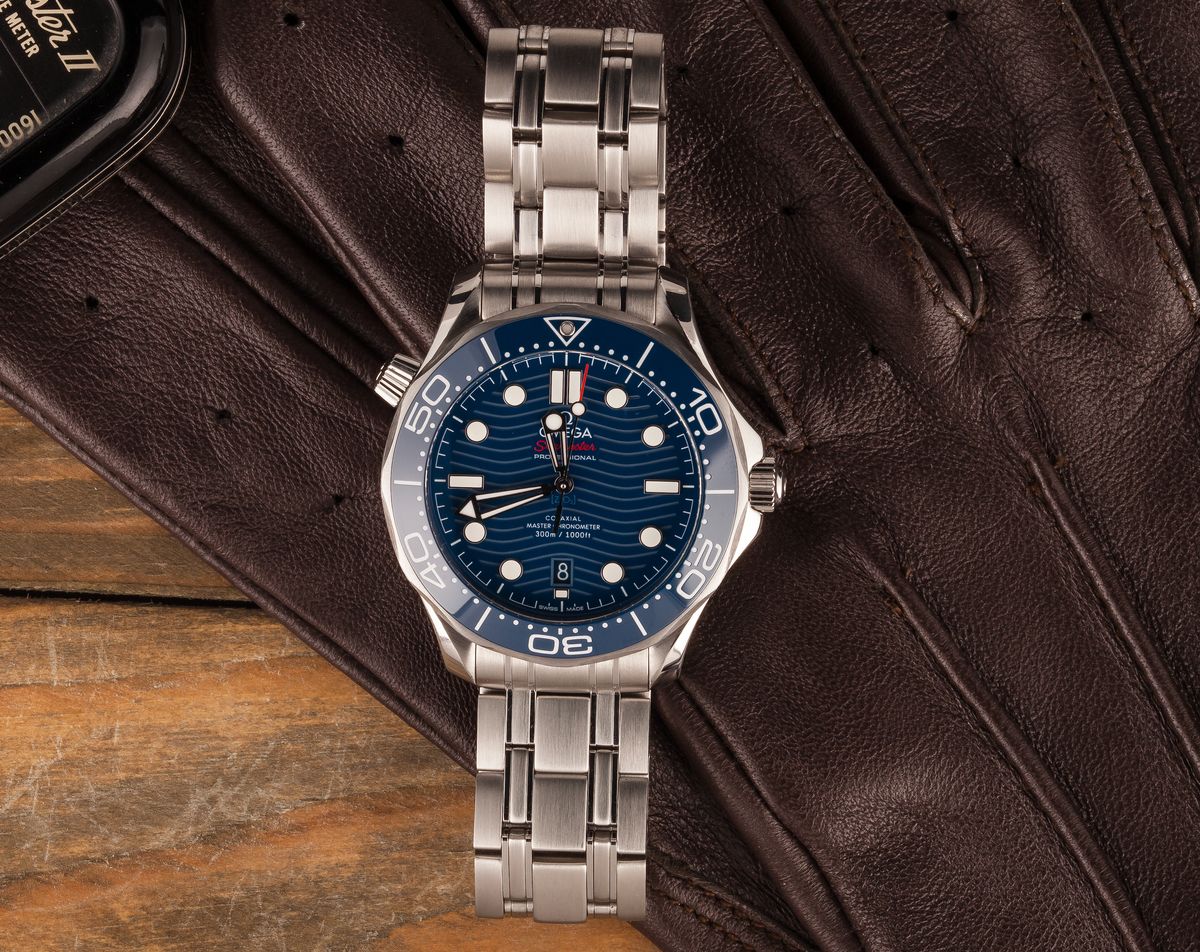
The Seamaster 300 Arrives
The CK2913, like its contemporaries, employed all the same features paramount to a hardworking dive model. Offering a large-for-the-time 39mm case size, it too had excellent readability, with its studiously unfussy dial indexes – a mix of sharp, lume-filled triangles and Arabic numerals at the cardinal points. The broad-arrow hands were similarly legible, and the simple coin-edged black bezel rotated to aid divers in keeping track of immersion times.
However, the Seamaster’s bezel was noticeably thinner than its rivals. In addition, the first two versions of the CK2913 had what are known as ‘back count’ or ‘countdown’ bezels, where the numerals count down clockwise from 50 to 10, the opposite of how we would see them today. There were actually seven variants of the CK2913; the other five reverting to the standard forward counting numerals. However, the original Breitling Superocean had no numerals on its bezel at all.
Of course, the key to all dive watches is the winding crown, traditionally the weakest link in any design and the most likely point of water ingress. Rolex held the patent for the screw-down type and so Omega developed its own system. Dubbing it the Naiad (after the Greek for water nymph) it mounted the crown on a special pressure-sensitive spring inside the casing, so the deeper the watch was taken, the tighter the seal would get. It meant the Seamaster’s performance at greater depths was virtually unparalleled, but the downside was that it was prone to leaks at shallower levels.
Like the Speedmaster, Omega’s new underwater companion proved to be a big hit with the public. It has stayed in production ever since; however in the years since its initial introduction, Omega has slapped the name Seamaster on a bewildering array of different types and styles of timepieces. Omega wouldn’t really regain its focus until the mid-1990s when it released the first of the Seamaster 300M range. A tough and extremely good-looking creation, it found its way onto James Bond’s wrist in Goldeneye, and hasn’t looked back. Agent 007 has worn an Omega, and usually some form of Seamaster, in every film ever since.
Just as Breitling scored a significant success by returning to the beginning, so has Omega in the shape of a number of heritage pieces of its own. In 2014, Omega introduced a production-run model, harking back strongly to the original Seamaster diver but with modern twists, called the Omega Seamaster 300 Master Co-Axial Chronometer. Both it and Breitling’s retro-inspired model are proving strong sellers in today’s market, as are the rest of the two company’s dive models. Below, we put the pair of nostalgic classics against each other.
Breitling Superocean Heritage II
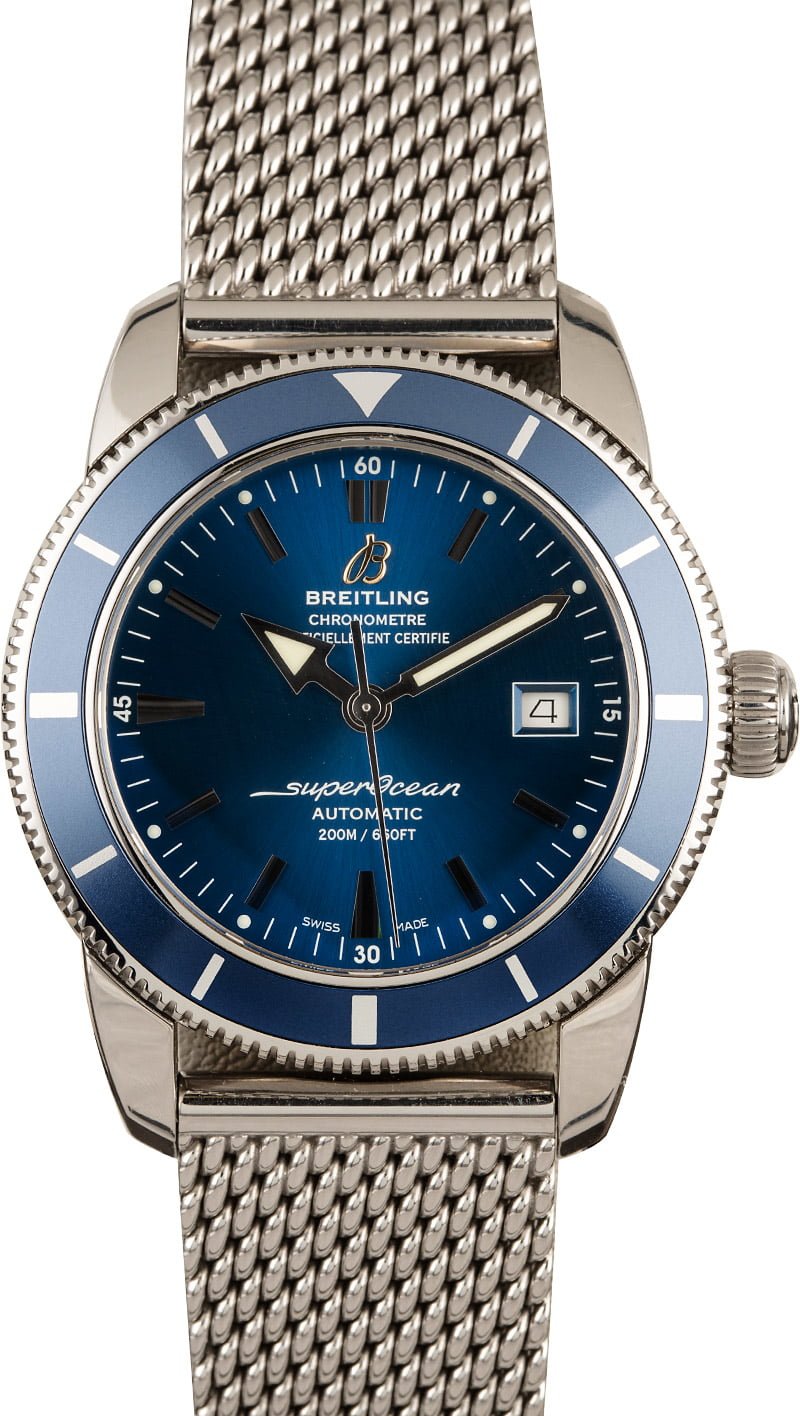
Superocean Heritage II Key Features:
Case Size: 42mm; 44mm; 46mm
Functionality: Time-Only; Time w/ Date; Chronograph w/ Date; Chronograph w/ Day-Date
Materials: Stainless Steel; Steel and 18k Red Gold; 18k Red Gold
Dial: Blue; Black; Silver; Green
Bezel: Blue; Black, Unidirectional w/ Ceramic Insert
Crystal: Cambered Sapphire, Glare-Proof (both sides)
Movement: Breitling Manufacture B20; Breitling Manufacture B01; ETA-Based B13; ETA-Based B10
Water Resistance: 100 meters / 330 feet; 200 meters / 660 feet
Bracelet: Leather; Rubber; Steel; NATO
Retail Price: $4,380-$19,600
Omega Seamaster 300
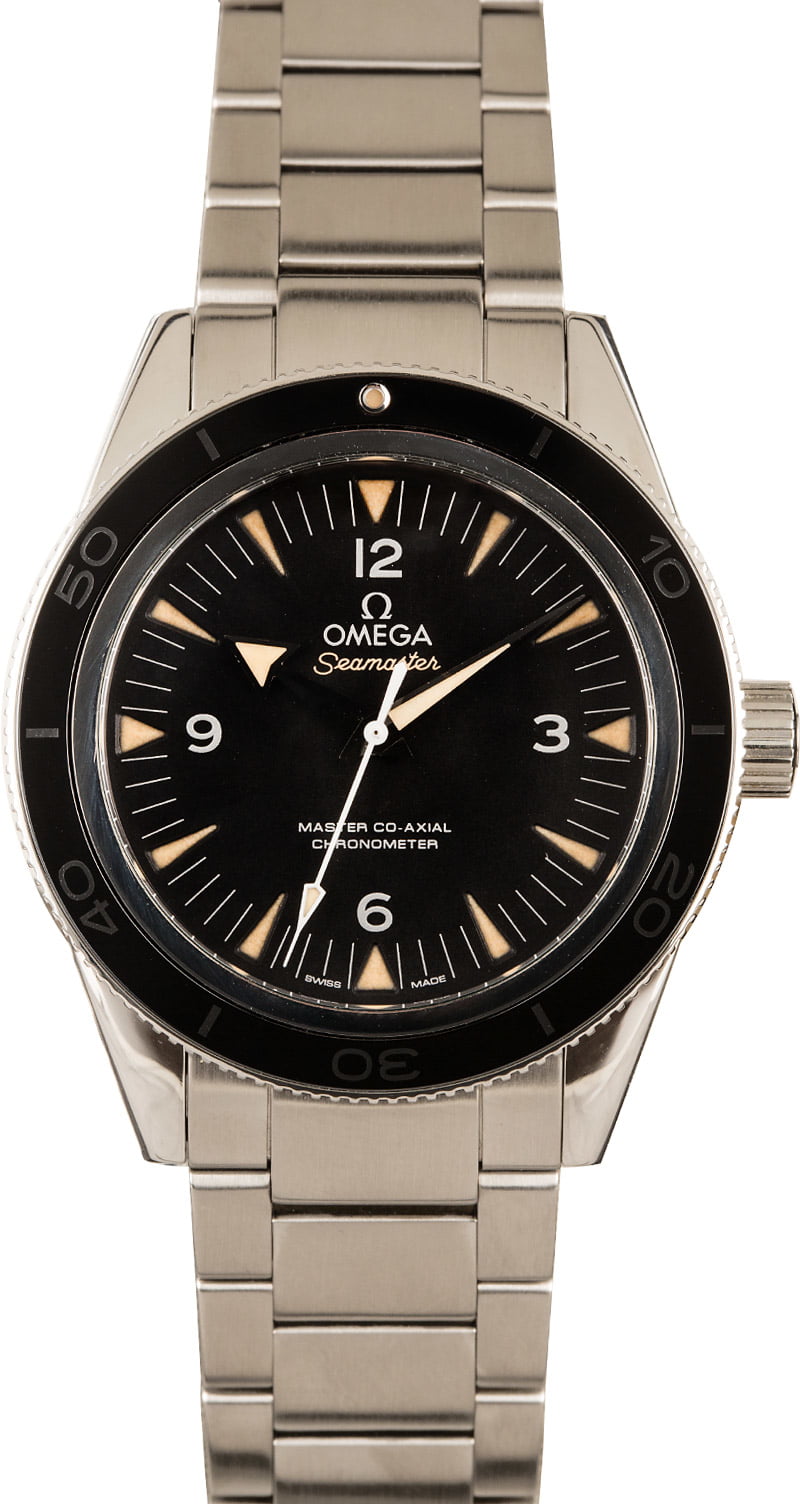
Seamaster 300 Key Features:
Case Size: 39mm; 41mm
Functionality: Time-Only
Materials: Stainless Steel; Steel and Yellow Gold; Steel and Sedna Gold; Yellow Gold; Sedna Gold; Titanium; Platinum
Dial: Blue; Black; Green
Bezel: Blue; Black; Green, Unidirectional w/ Ceramic Insert
Crystal: Domed Sapphire, Glare-Proof (inside)
Movement: Omega Manufacture Master Co-Axial Caliber 8400; Master Chronometer Caliber 8913
Water Resistance: 300 meters / 1,000 feet
Bracelet: Leather; Steel; Steel and Gold; Solid Gold; Solid Platinum
Retail Price: $6,500-$66,000
Breitling Superocean Heritage II vs. Omega Seamaster 300: Features and Options
Omega
At their most basic, both the Seamaster and Superocean are simple, time-only models that reflect their respective originators. For the Omega Seamaster 300, that is also where it ends. Each of the 27 pieces in the series is an elegant three-hander, with nothing extraneous to muddy up the symmetry and minimalism of the dial.
The main difference between the watches lies in their metals and bracelets. The all-steel version on a brown leather strap marks the entry point, closely followed by a pair of titanium examples, two-tone blends of steel and gold, and finally ending with the top-level models crafted from solid 18k gold (yellow or Sedna) or the shimmering luxury of platinum. Each variant is sized at 41mm except for the limited edition 1957 Trilogy model which is a period-exact 39mm and only available in stainless steel.
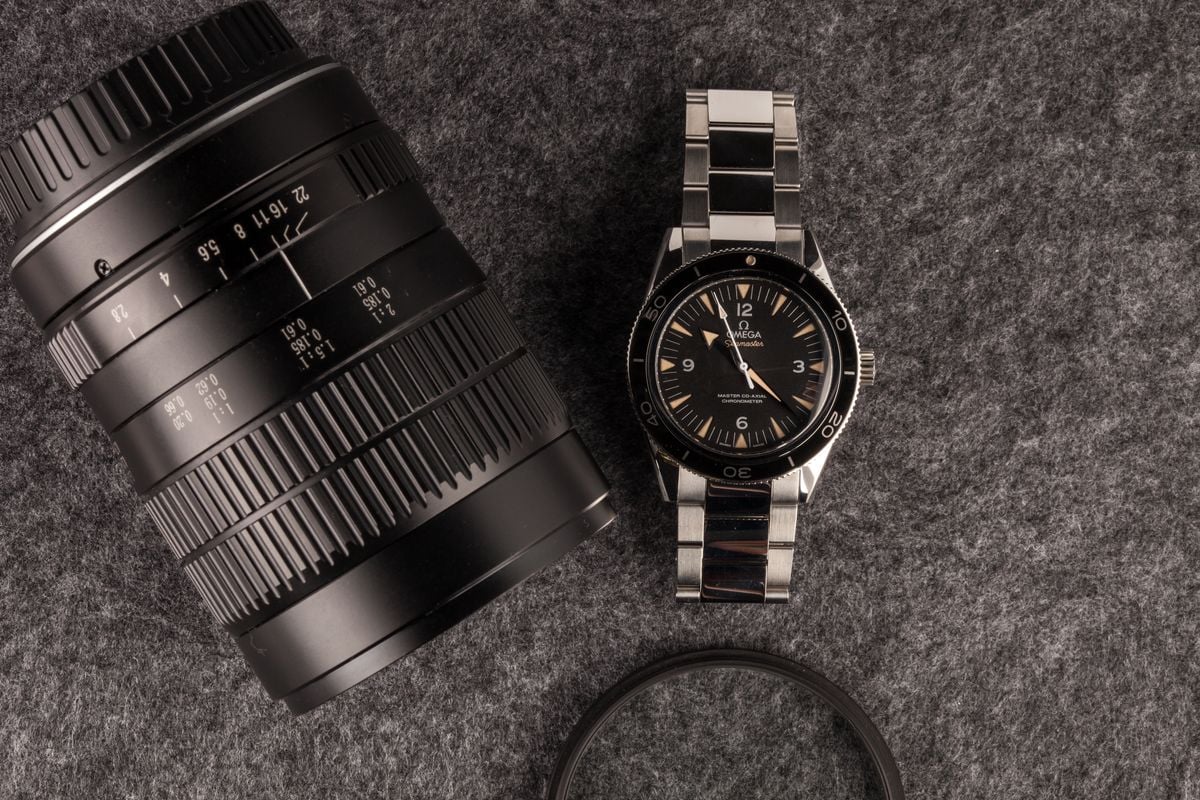
Breitling
The Breitling Superocean also has time-only models, but only in its so-called ‘Capsule’ and ‘Boutique’ collections. What are they? Well, the Capsule Collection models are not officially limited editions as they’re not numbered, but they are only being produced for a specific amount of time (so they are limited editions in all but name). As it pertains to the Superocean Heritage II, that leaves us with a handful of the closest recreations of the initial Superocean ref. 1004 from 1957.
As for the Boutique Collection, these are genuine, numbered limited editions. The Superocean Heritage ’57 is a black dial, three-hand piece with quirky rainbow-colored indexes, emitting a real beach hippie vibe – and ‘ONE OF 250’ engraved on the back. All simple enough? Not so fast! There is also another version of the colorful Boutique model, this time with blue detailing, just called a Limited Edition and restricted to 1,000 units, with a proportion of the profits going to frontline Covid-19 charities.
The rest of the contemporary catalog consists of both time-and-date watches and chronographs, with all models carrying on the tradition of the debut ref. 807. There are Limited and Boutique versions of both of these as well, including the top-of-the-range all-Sedna gold Superocean Heritage B20 Automatic 42.
On the whole, Breitling certainly has the most variation, especially when you take its choice of sizes into consideration as well. Most of the range is available in 42mm and 44mm, which is relatively restrained by Breitling’s standards. There are also two pieces in 46mm, both time-and-date in steel, with either all black on a mesh steel bracelet or blue on a rubber strap and a newer ladies range in 38mm.
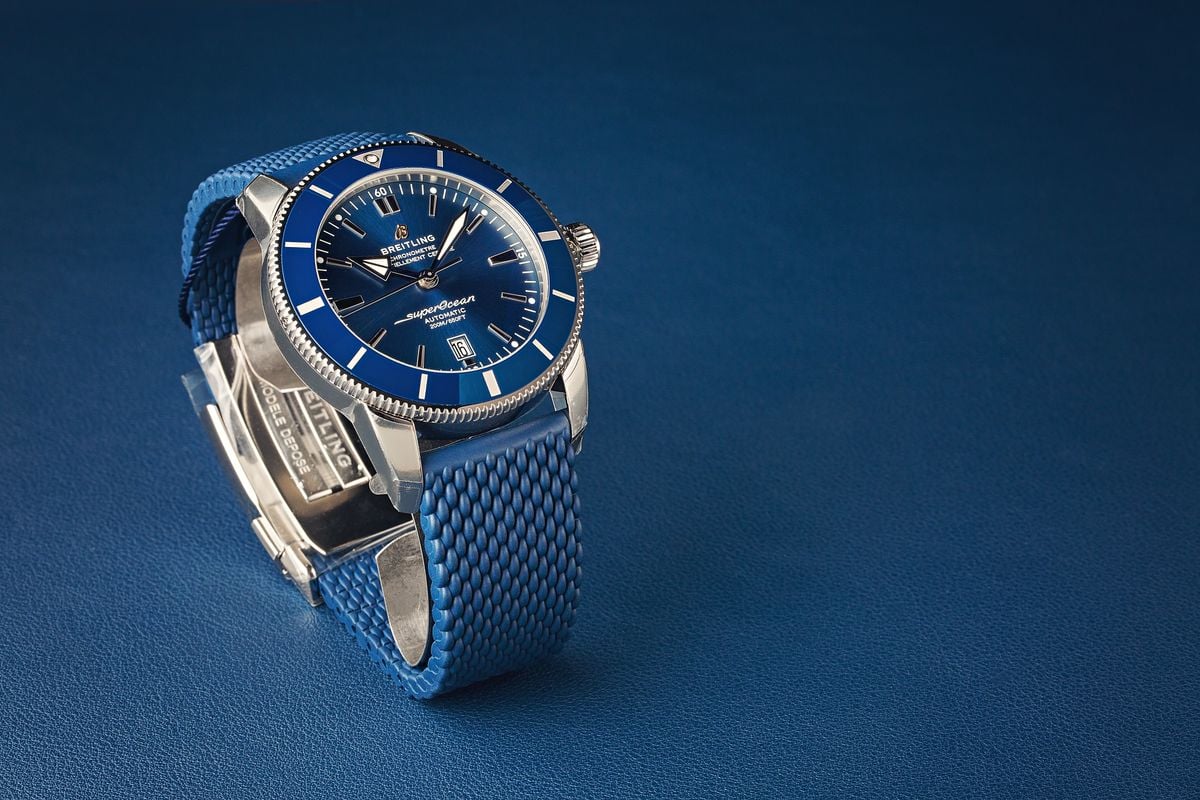
Breitling Superocean Heritage II Vs. Omega Seamaster 300: Aesthetics
Omega
One aspect both the Seamaster and Superocean collections share is a full-production roster that takes the debut models as an aesthetic starting point, building on them to appeal to a modern audience, as well as limited edition pieces that are virtually exact copies.
Of the two brands, it is arguably Omega that has stayed truest to the vintage original. The main Seamaster 300 range takes plenty of design prompts from the CK2913, most noticeably in the handset and hour markers, which are lifted almost directly from the inaugural model.
If you wanted to get really technical about it, the contemporary piece is closest to the third iteration of the first watch, the CK2913-3. It has the trademark broad arrow hand with a forward counting bezel. With that in mind, the small arrow on the seconds hand is a modern touch.
The bezel, although slightly thicker than on the debut Seamaster, still has the same clean styling, with hash marks only at five minute intervals all the way round, as opposed to for the first 15-minutes as you would find on later examples. Options-wise, there is something for everyone. The steel all-black model manages the trick of being both handsome and understated, while the titanium versions with blue dials and bezels subtly up the wrist presence. If incognito isn’t your thing, the two-tone pieces are more noticeable, while the 18k gold and platinum-crafted watches at the highest end scream for attention.
However, the real triumph (for vintage fans at least) is the beautiful limited-edition 39mm. It is a virtual photocopy of the CK2913 and is something that looks as if it has just been retrieved from a vault after more than 60-years. Omega has recreated every last detail, right down to the 1950s font for the dial script. While it features a sapphire crystal rather than one made from acrylic like on the original model, Omega has even gone as far as to put a tiny Omega logo engraving in the center – just like the ones found on the brand’s acrylic crystals.
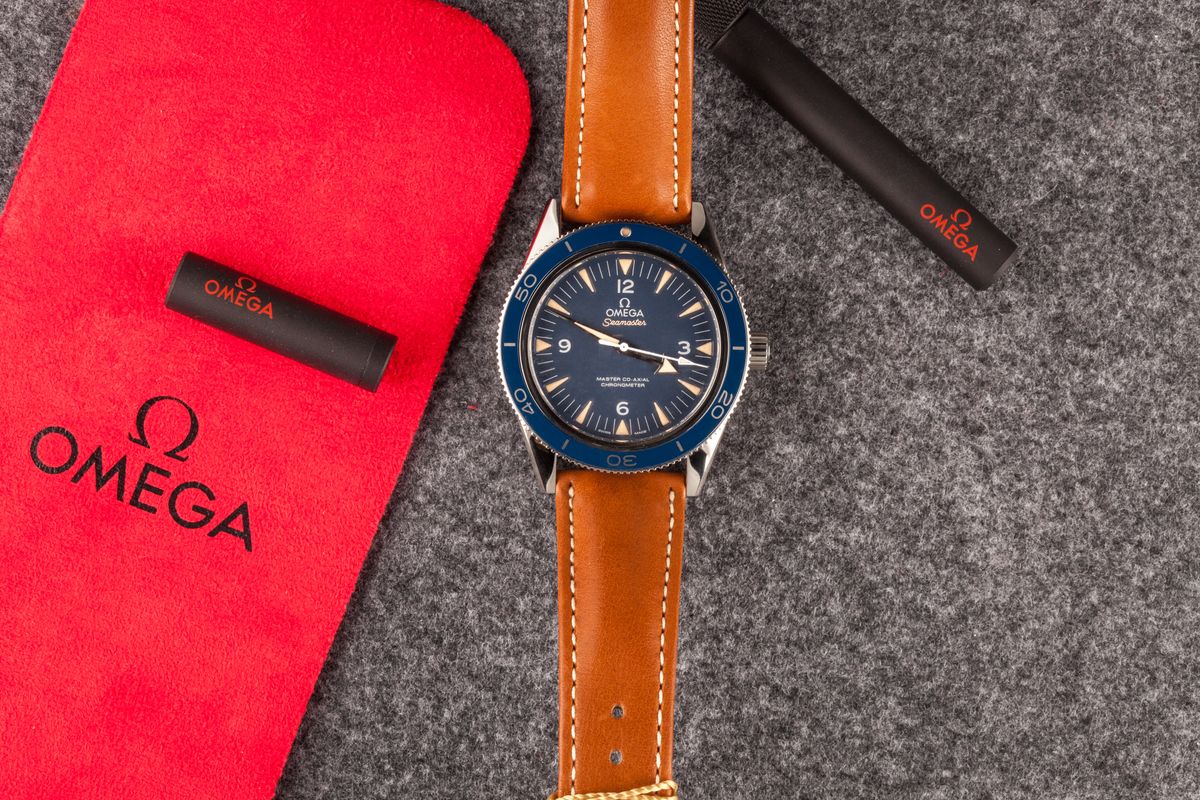
Breitling
Compared to the Seamaster 300 series, Breitling’s collection of Heritage models has gone further with the modernization. While even the smallest of the three available sizes (excluding the ladies 38mm option) is far larger than the original (42mm compared to 39mm), the overall shape has been extensively modified too. The lugs are longer and about twice the thickness of the ref. 1004 and 807, leaving the whole watch looking taller and significantly less squat and rounded.
However, the dial is a reasonably close recreation, and the handset especially. The sword-type minute hand and large arrow-tipped hour hand are both filled with lume and are highly readable, as befits a dive watch. The indexes though are shorter than on the inaugural model and without the circular plots at the four main points. And the date function tucked away at six o’clock is not something that you will find on the original either.
As for the bezel, that has the same sparsity of numerals, consisting of just simple lines at the five minute marks. Bearing in mind the attention-grabbers Breitling has produced in the past, the Superocean Heritage collection is remarkably toned-down, and without any of the bright luridness we see at the top end of the Seamaster range. The most eye-catching pieces are the all-blue examples, and even those are admirably restrained and undemonstrative.
Again, the limited-edition pieces, whether in the Capsule or Boutique Collections, run the first editions a very close race. Here, most of the basics are practically indistinguishable from the 50s model (the one exception being the use of modern materials), with the different color schemes being the primary separating factor. Strangely however, Breitling has also opted to issue them as 42mm watches – a decidedly non-vintage size for a heritage-inspired watch.
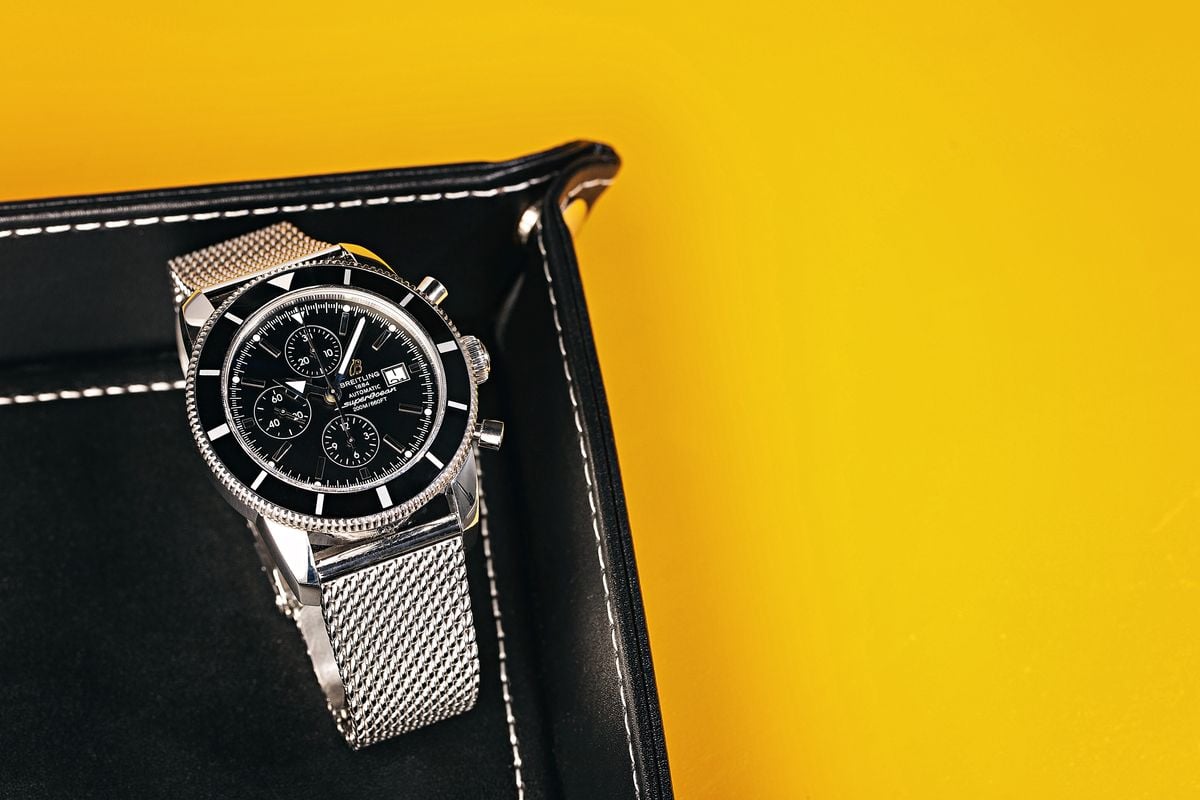
Breitling Superocean Heritage II Vs. Omega Seamaster 300: Movements
Omega
It would be wrong to lay all of the credit for Omega’s resurgence over the last couple of decades at the feet of its new catalog of in-house movements, but it is impossible to deny that they have had a massive effect. Since the adoption of George Daniels’s Co-Axial escapement, Omega has continued to make great strides in its technology. For example, Omega is the first company to mass-produce silicon hairsprings, the main contributing factor to the new movements’ antimagnetic Master Co-Axial certification.
Omega leads the way in producing watches impervious to the effects of magnetic fields, one of the major causes of timekeeping inaccuracies. By focusing on building components from non-magnetic components materials rather than simply shielding them with a soft iron cage (à la Rolex’s Milgauss), Omega has created models that can withstand more than 15,000 gauss while still keeping the cases a wearable size.
The Caliber 8400 inside the majority of the Seamaster 300 models contains all of Omega’s most up-to-date advancements, the Si14 hairspring included, as well as an automatic winding system that pivots on ball bearings. This greatly reduces the wear to one of the components most affected by friction, thus reducing the frequency of necessary servicing.
Perhaps best of all, although not particularly faithful to the original, is the display case back on the Omega Seamaster 300 Collection. The quality of finishing on the Caliber 8400 is extraordinary for a watch in this price group, and being able to view it in action is a real treat. As with the rest of the Co-Axial calibers, this one beats at 25,200vph (considered the optimum frequency for this kind of escapement) and offers users a 60-hour power reserve.
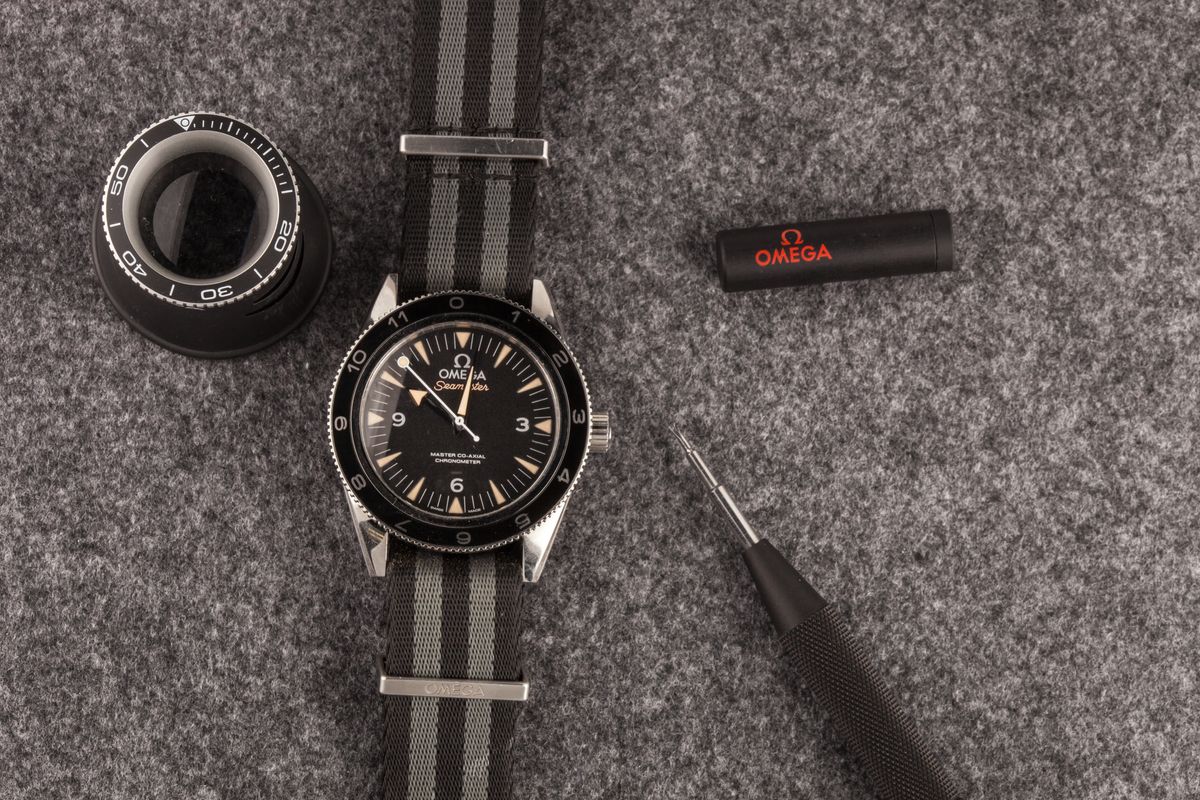
Breitling
The first generation models from Breitling’s Superocean Heritage collection were all powered by ETA-derived movements. However, when the Swatch Group completed the acquisition of the ébauche manufacturer a number of years, the Swiss Competition Commission (COMCO) ruled the conglomerate was now a virtual monopoly and stepped in to regulate the ETA supply of movements to any non-Swatch companies until the end of 2020.
This created a tricky situation for Breitling (wholly owned by CVC Capital Partners) and led the brand to formulate an arrangement with Rolex’s sister company, Tudor. The Caliber B20 inside the time-and-date Superocean Heritage models is actually a slightly reworked Tudor MT5612. Breitling still describes it as an in-house movement, although it doesn’t specify exactly whose house it is referring to here.
Nevertheless, it is an impressive, no-frills workhorse and the perfect accompaniment to this type of watch. Its 70-hour reserve outdoes the Omega Cal. 8400, but the movement doesn’t benefit from a silicon hairspring – although, curiously, the Tudor MT5612 does, and Breitling replaces it as one of its modifications.
As for the rest, they are powered by a range of engines. The Cal. B01 is a genuine in-house chronograph (and the movement supplied to Tudor for its Black Bay Chrono model in exchange for the MT5612) and it is fitted to the 44mm pieces with 3/6/9 chronograph counters. The remaining two movements are both ETA-based, with the B13 (taken from the ETA 7750) driving the day-date chronographs with the 12/6/9 sub-dials, while the limited edition time-only models use the B10, once the ETA 2892-A2.
Each of the four Breitling movements beats at 28,800vph and are (of course) COSC-certified. Furthermore, all are well-proven and highly reliable mass-produced calibers, although we are still waiting to see what Breitling will be using instead of the third-party mechanisms when the time comes.
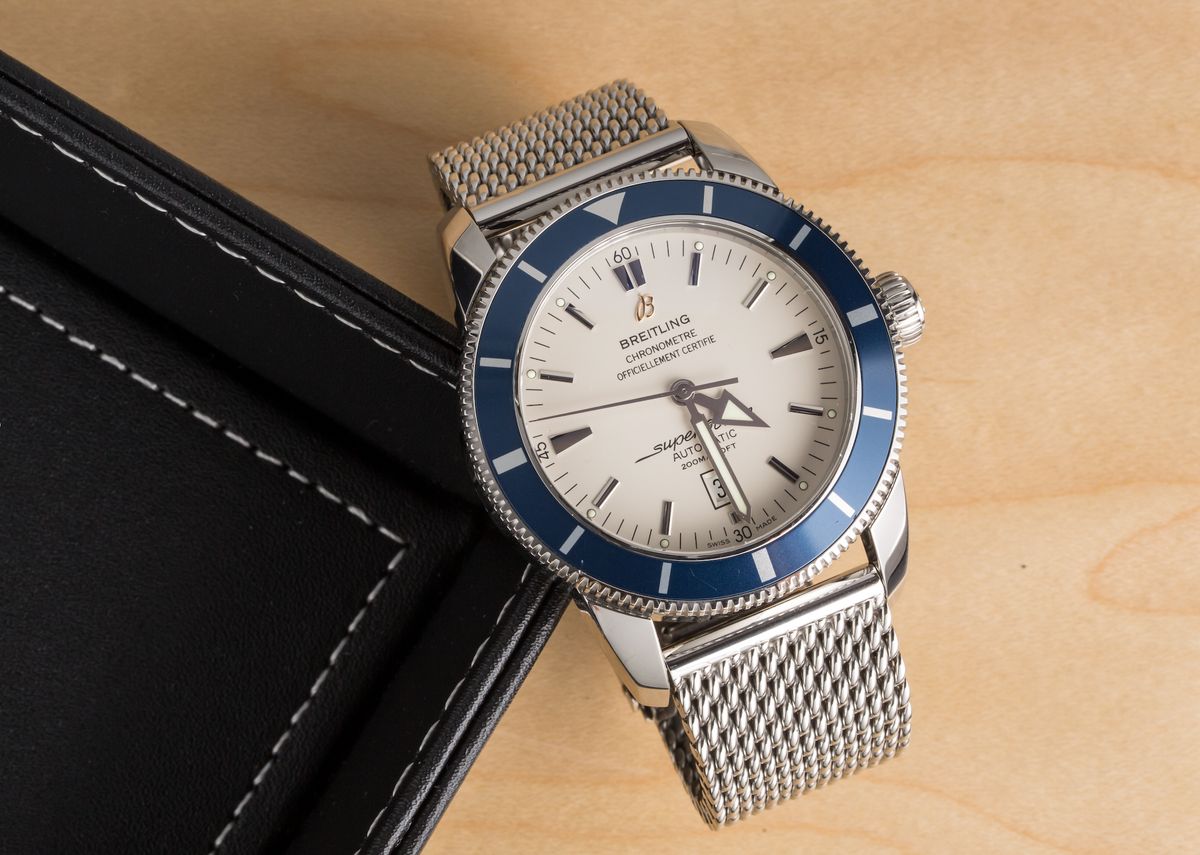
Breitling Superocean Heritage II vs. Omega Seamaster 300: Final Thoughts
It is difficult to overstate just how well both brands have done on these rejuvenated blasts from the past. Each has stuck incredibly close to the DNA of their respective originals, with any renovations sympathetic rather than radical. Improvements have been made where appropriate, and both have been granted modest size increases and materials to appeal to modern audiences.
But who has done it better? Well, in terms of choice, Breitling has it wrapped up, with plenty of complications, colors and sizes; however, many collectors still favor the Omega. The stylists for both brands haven’t put a foot wrong with their designs, and they have both come up with collections of attractively discreet tool models in a range of ideal colorways. They are all driven by faultless movements, and both collections are backed by brands that keep scoring success after success.
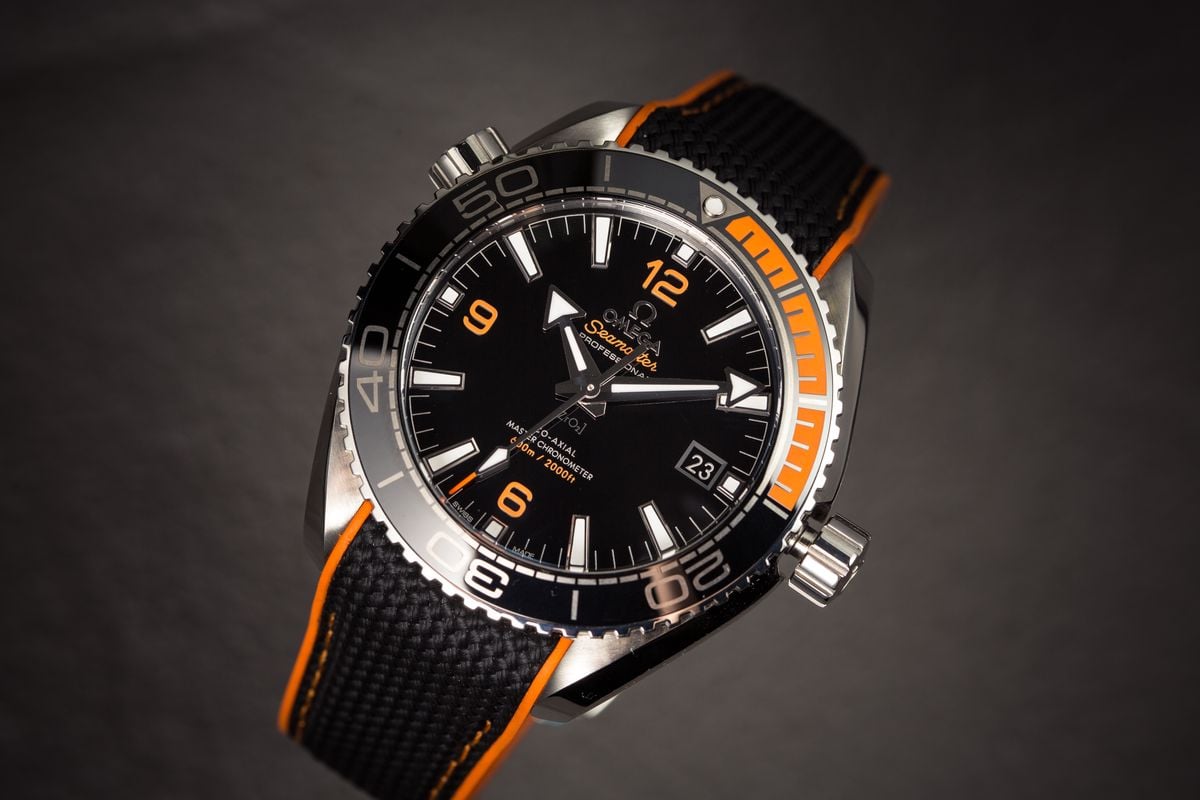
Breitling Superocean Versus Omega Planet Ocean
Although Omega has rationalized its collections significantly over the last few years, there are still an awful lot of watches on its books with the name ‘Seamaster’ somewhere in their title. They include everything from the entry-level Aqua Terra models to the Heritage watches seen above, the Railmaster (for some reason), all the way through to the great, slab-sided PloProf with its massive 1,200 meters of water resistance.
In-between, we find two other series, the Diver 300M and the Planet Ocean 600M. The former will be recognizable, and particularly the blue dial and bezel variant, to anyone who watched Pierce Brosnan play James Bond. It remains Omega’s best-selling Seamaster group and now has more than 50 models in the lineup if you count all of the different colorways and configurations.
The Planet Ocean, on the other hand, was first created in 2005 as a bigger and tougher variation on the luxury dive watch. This sub-collection within the Seamaster family includes even more options than the Diver 300M and features both chronograph and GMT models, with each one rated down to 600 meters and produced in sizes of between 39.5mm (37.5mm if you count the limited editions) up to 45.5mm.
As for Breitling, its dive watch collections are much more clear-cut. They consist of the vintage-inspired Superocean Heritage that we’ve already covered above and the modern Superocean. As with the Planet Ocean watches, the mainstream Superocean models take few prisoners. The collection ranges from 36mm unisex models through to some great hulking 48mm behemoths, very much keeping in line with Breitling’s history of producing oversized wristwatches.
Depth ratings vary from 200m all the way to an incredible 2,000m. However, while they share few styling conventions among them, there are some definite similarities between the Breitling Superocean and the Omega Planet Ocean that make them ripe for a showdown. Below, we take a look in more detail.
Breitling Superocean
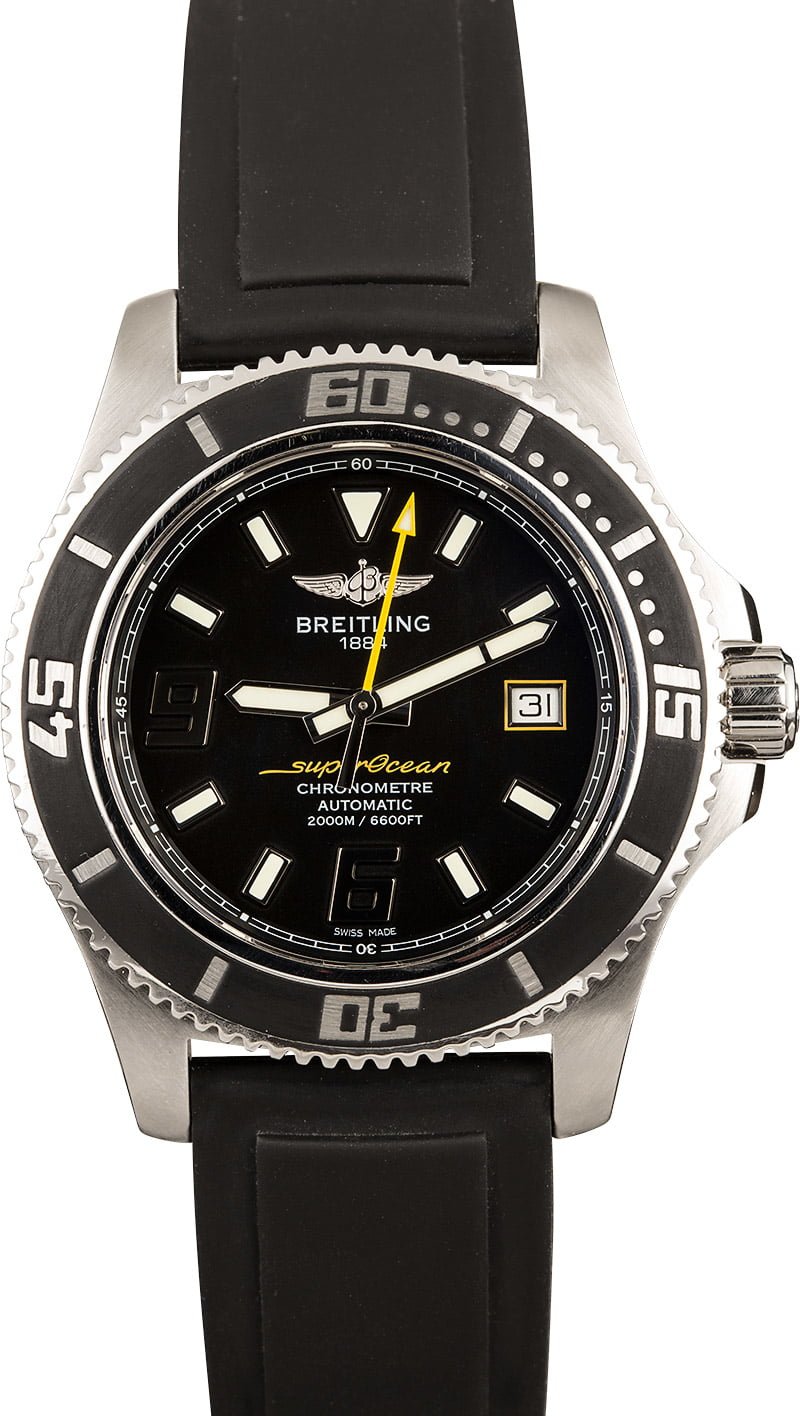
Superocean Key Features:
Case Size: 36mm; 42mm; 44mm; 46mm; 48mm
Functionality: Time-Only; Time w/ Date; Chronograph w/ Date
Materials: Stainless Steel; Titanium; Steel & 18k Red Gold
Dial: Blue; Black; White; Yellow; Orange
Bezel: Blue; Black; White, Unidirectional w/Ceramic Insert (bidirectional w/ locking mechanism on 48mm model)
Crystal: Cambered Sapphire, Glare-Proof (both sides)
Movement: Breitling 17
Water Resistance: 200 meters / 660 feet – 2,000 meters / 6,600 feet
Bracelet: Rubber; Steel; NATO
Retail Price: $3,450-$6,100
Omega Seamaster Planet Ocean 600M
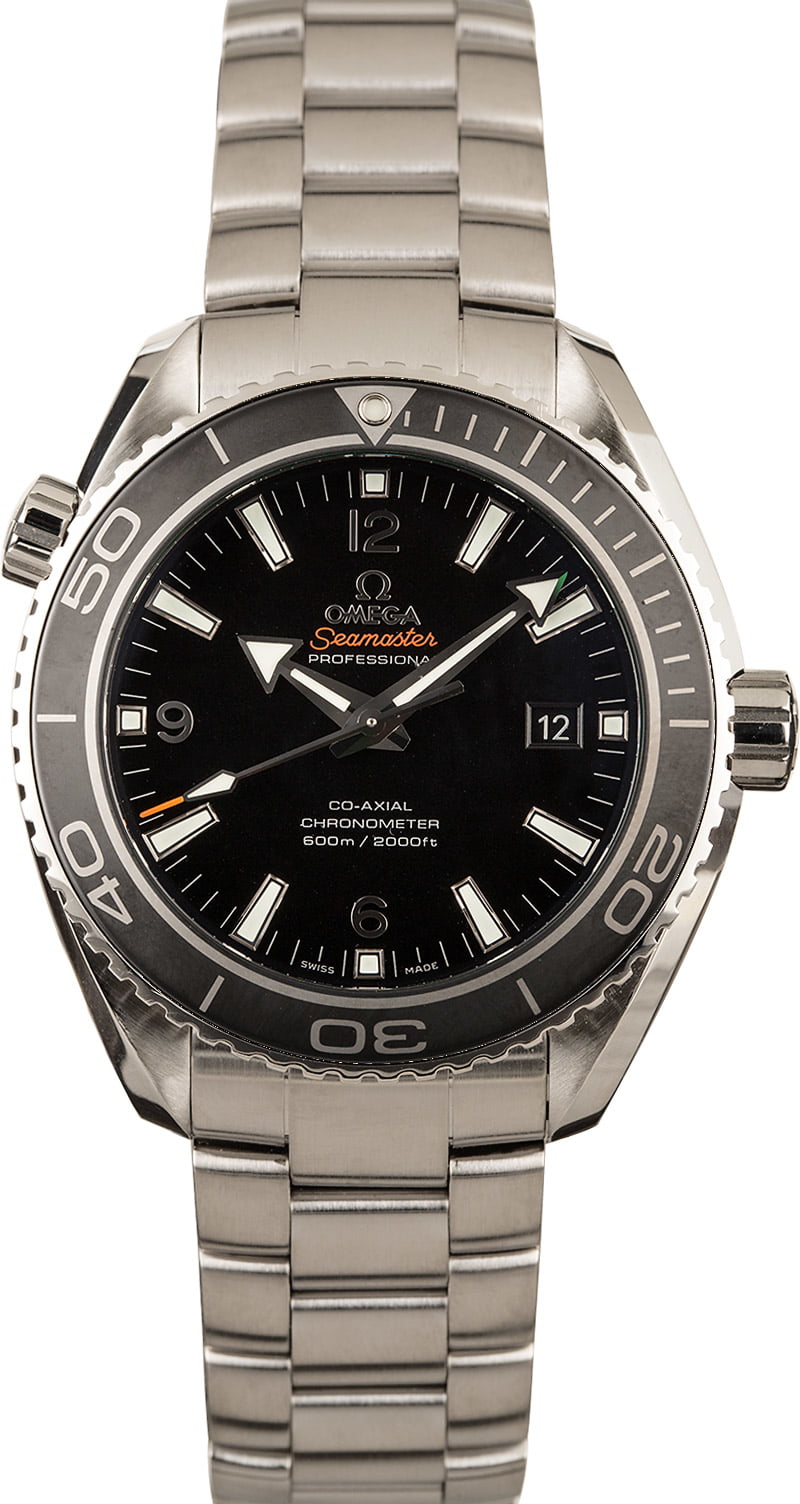
Planet Ocean Key Features:
Case Size: 37.5mm; 39.5mm; 43.5mm; 45.5mm
Functionality: Time w/ Date; Chronograph w/ Date; GMT
Materials: Stainless Steel; Steel and Sedna Gold; Sedna Gold; Ceramic; Titanium; Platinum
Dial: Blue; Black; White; Grey; Brown
Bezel: Orange; Blue; Black; White; Grey; Gem-Set, Unidirectional with Cramic insert (bidirectional on GMT models)
Crystal: Domed Sapphire, Anti-Reflective Treatment (both sides)
Movement: Omega Master Co-Axial Caliber 8800/8801/8900/8906/9900/9901
Water Resistance: 600 meters / 2,000 feet
Bracelet: Steel; Steel and Sedna Gold; Titanium; Leather; Rubber; NATO
Retail Price: $6,450-$95,000
Breitling Superocean Vs. Omega Seamaster Planet Ocean 600M: Features and Options
Omega
While both collections offer plenty of variety, designed to suit any and all tastes, the Planet Ocean series stands out in front. All told, there are more than a hundred different flavors of the watch, in five sizes, seven different metals, five dial colors, and three types of complication.
However, although there is no doubting the lavishness of the range, each watch still very clearly means business. Even the smallest in the lineup has a significant heft, equipped with a noticeably thicker case than Omega’s Diver 300M models, in order to cope with the pressures of a 600-meter water resistance rating. On top of that, a manually operated helium escape valve is fitted to each one at the10 o’clock location. Will you ever need to use it? No, of course not. But it’s nice to have anyway.
In terms of functionality, you can take your pick between simple time-and-date pieces (which make up the majority of those available), a handful of GMT models, and a number of chronographs. The chronograph models are only available in the largest 45.5mm size, while the GMT watches are only available in 43.5mm or 45.5mm, but you do have a choice in size for the various time-and-date models.
Materials are top-notch, as you would expect from Omega’s premium diving line. Steel and two-tone are the most accessible, running through grade 5 titanium examples and on up to solid 18k Sedna gold and Platinum editions. Similar to the brand’s Speedmaster Dark Side of the Moon range, some of the watches in the Planet Ocean collection are crafted from colored ceramic.
Bezels are similarly high-tech. Most of the inserts are also made of ceramic, with the majority given a Liquidmetal™ diving scale. Liquidmetal™ is a proprietary process developed by Omega that permanently bonds the ceramic bezel insert and it metallic numerals, creating a single component engineered for maximum durability and longevity. One-upping even that, the gold models feature Ceragold™ – another Omega-devised method that allows the watchmaker to encrust ceramic with 18k gold and has resulted in the industry’s first-ever ceramic bezel with gold markings that are completely smooth to the touch.
All in all, the Omega Planet Ocean series manages to tread that line between having the abilities of a full-throated sports model and the general bearing of a luxury watch – all from a manufacturer that is at the top of its game.
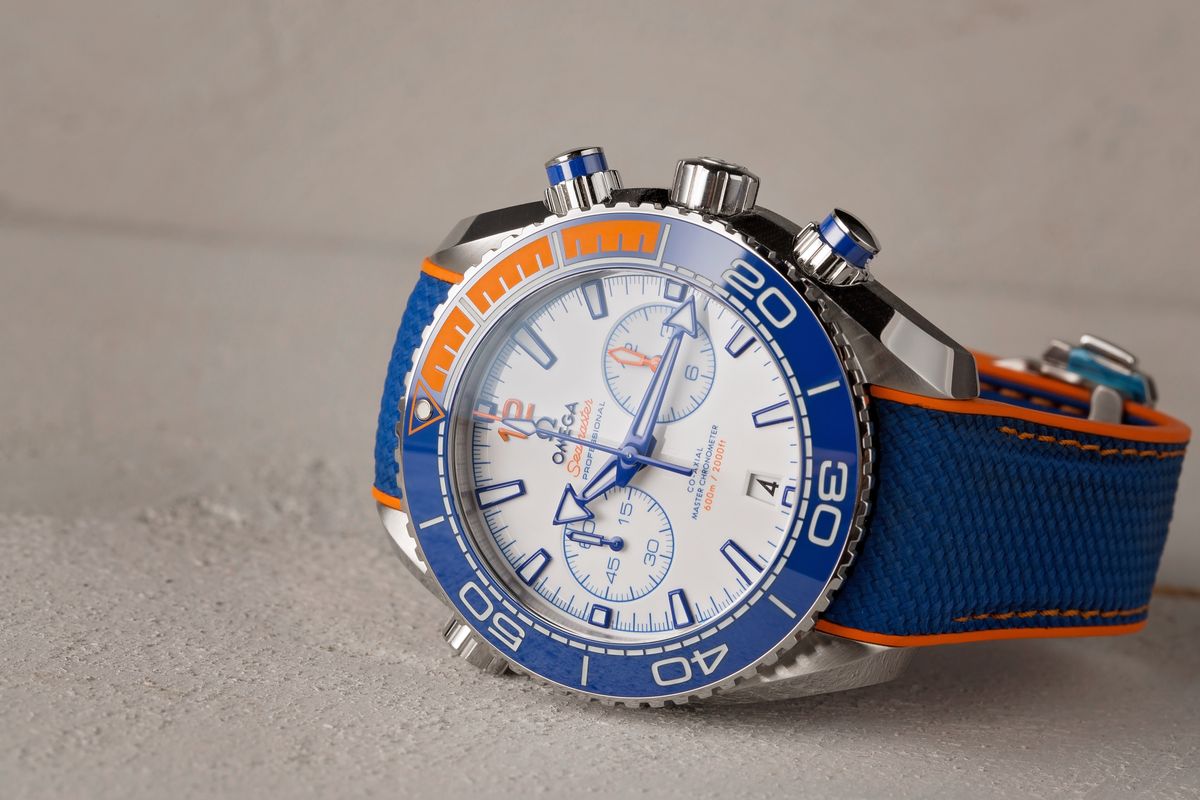
Breitling
In comparison to the Omega, Breitling’s Superocean range is a far more agricultural collection. You won’t find any fancy new alloys or molten gold liquids here, and a chronograph with a date function is as complicated as it gets. You don’t even get a helium escape valve on every model, and it is only found on those rated to 1,000m and deeper.
What you get instead (for the most part) is some good old fashioned Breitling machismo. Most of the collection is forged from stainless steel, with a handful of those being DLC-coated a manly matte black, with one of them given a splash of red gold to the bezel – just about the only concession to a touch of opulence. The remaining examples all have 48mm titanium cases, again with a black DLC coating.
Although the engineering may be a bit less advanced than what is found on the Omega, the Superocean’s talents are prodigious. The smallest 36mm models, clearly aimed at opening up Breitling’s roster to women at long last, are still waterproof to 200m. Yet the 46mm examples take that all the way down to an astonishing 2,000m (6,600ft), dwarfing not only Omega’s Planet Ocean range but also the PloProf – a watch commissioned by and built for hardcore saturation divers. (Curiously though, the enormous 48mm Superocean pieces with the special locking bezel and soft iron inner case are only rated to 300m, despite their burly looks).
As a whole, there is little about the Breitling Superocean family that would lead you to use the word subtle, but that is rather the point. These are larger-than-life professional dive watches aimed at outgoing people, and they fulfill their role superbly.
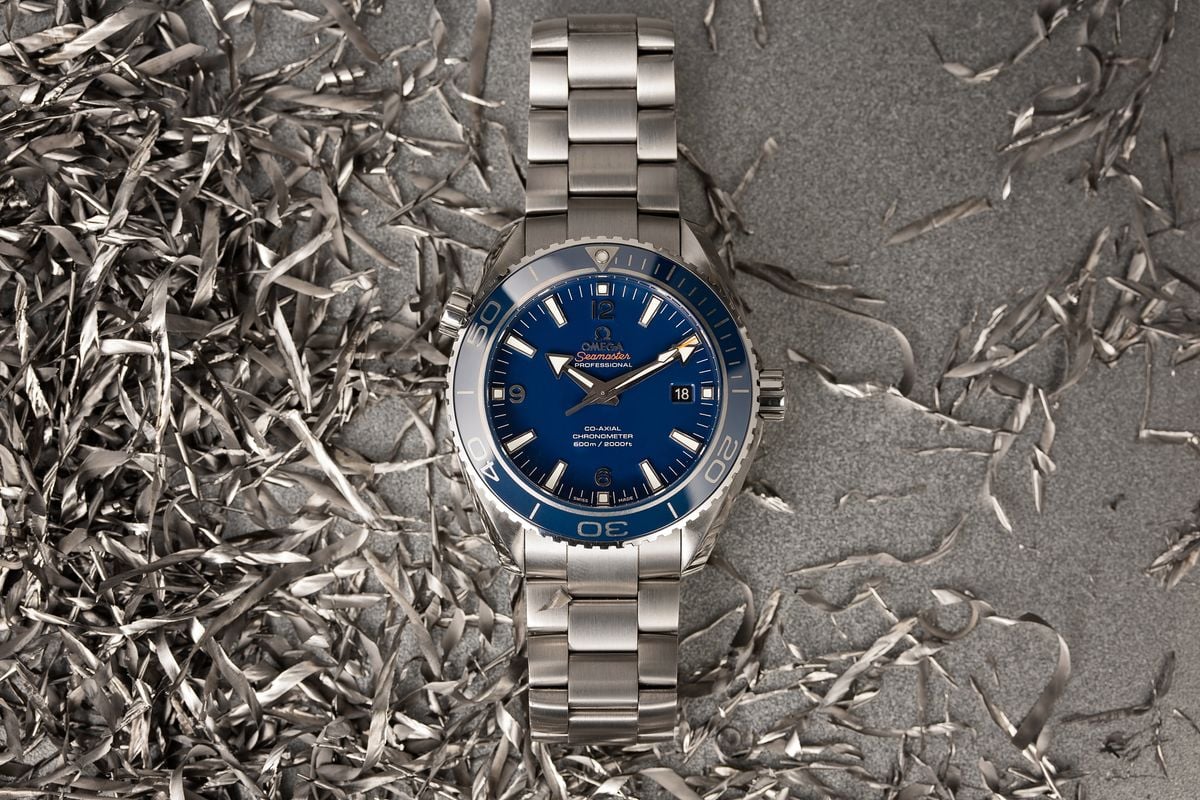
Breitling Superocean Vs. Omega Planet Ocean 600M: Aesthetics
Omega
With more than 100 models available and spread around a wide sizing spectrum, the Omega Planet Ocean collection is the epitome of the ‘something for everyone’ rule. While all the models share a relaxed elegance due to their design and form, there are still plenty of distinct personalities in the collection. The range can be bright and playful, such as with the 43.5mm ref. 215.32.44.21.04.001, with its bezel, indexes and NATO strap all accented in a vivid orange (the unofficial signature color of the Planet Ocean series).
At the opposite styling extreme, watches like the 39.5mm ref. 215.63.40.20.13.001 are achingly sophisticated, with a case forged from Omega’s own red gold (named Sedna) and offering one of the more successful uses of chocolate brown for the dial and bezel, continued onto the rubber-backed leather strap. The look gives off both an incredible, luxurious warmth and a cultured understatement.
One of the most varied sub-collections groups within the lineup is found across the various dual time zone models. This is where you will see the bulk of the ceramic-cased Planet Ocean pieces, with most of them in jet black and a few in deep blue. Some of the bezels have been given pops of intense color, generally mirrored on the GMT hand, while others have been left rather monochromatic. There is also one with a beautiful Sedna gold, but the standouts are the two steel references (the ref. 215.30.44.22.01.001 and the ref. 215.33.44.22.01.001), each fitted with the world’s first black and white polished bi-ceramic bezel.
Elsewhere, Omega really has covered all the bases. There are models for just about any sensibility, and the vast majority of them do what the best luxury dive watches have always done; retain a certain versatility that pairs with any outfit, whether it is a weekday business suit or kicking back at the weekend in jeans and t-shirt. Yet, the basics are consistent throughout. Each case has Omega’s trademark twisted lyre lugs, every reference uses the same broad arrow handset, all the time-and-date pieces have the same Arabic numeral markers at the 12/6/9, with a small date window at the three o’clock, and the chronographs have two sub counters in the same shade as the main dial.
As a whole, this consistency gives a welcome cohesion to the family, regardless of the rest of the color scheme. This is a group of visually arresting, highly accomplished divers that are issued in an intelligent range of sizes and made to find a home on virtually any wrist.
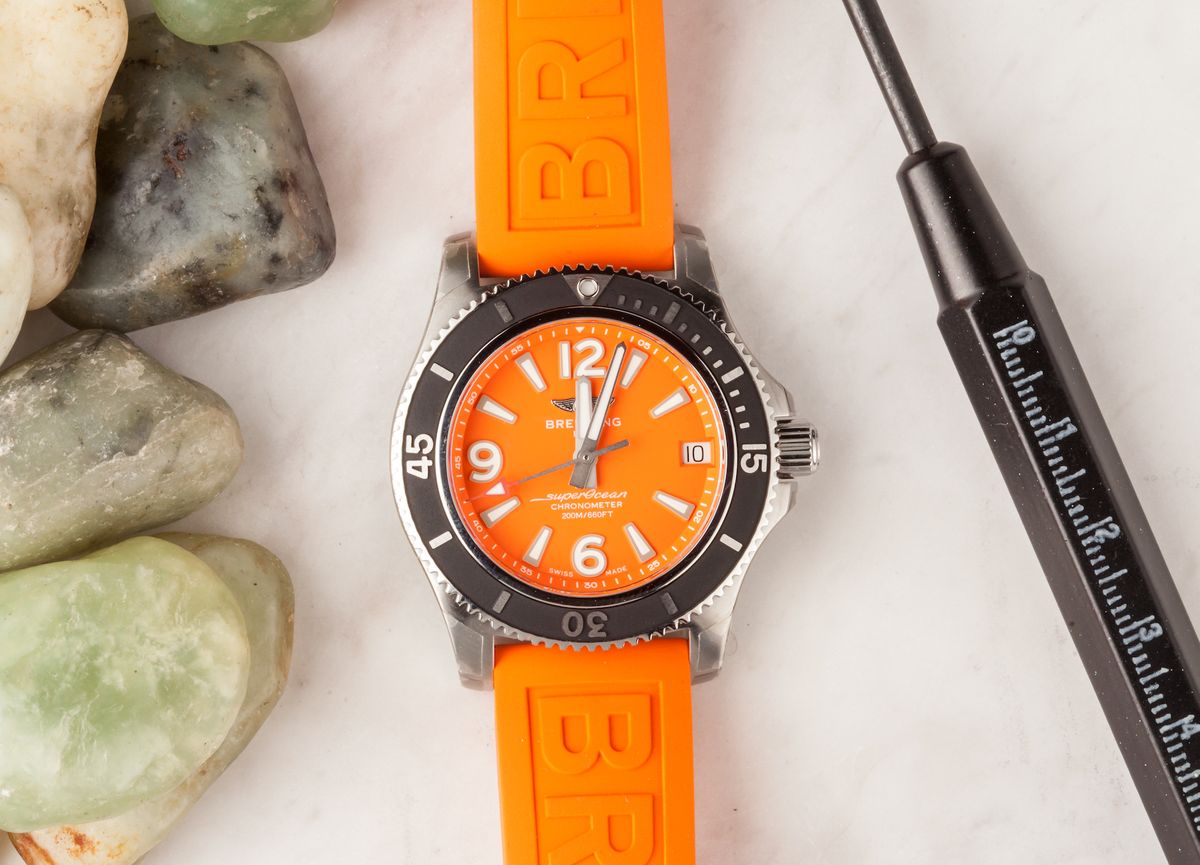
Breitling
What the Breitling Superocean loses to Omega in the refinement stakes, it more than makes back in presence. Just about as in-your-face a collection as you will come across, Breitling’s focus has clearly been centered on legibility and robustness. This latest catalog only emerged in the last few years, taking over from the previous generation – one which was criticized for an extremely busy-looking dial.
Indexes are still enormous with massive 12/6/9 numerals on many examples, coupled with large trapezoidal markers for the rest and thick, squared hands that are about 95% filled with lume. Regardless of size or materials, the cases all look bombproof and offer rather hefty crown-guards – something absent from the Omega, further underlining the Planet Ocean’s more dressy veneer.
While these are certainly dive watches worthy of the name, the flip side to that is arguably a loss of adaptability. Although there are a couple of models in the collection unobtrusive enough to coordinate with more formal attire, these are genuine sports models made to be worn during any and all strenuous activity.
That is underlined in the brand’s choice of dial colors. Along with the more traditional black, white, and blue, it is impossible to miss the dazzling yellow and orange dials, and some are even paired with a correspondingly vibrant rubber strap.
Overall, the Breitling Superocean series is a lot of fun. They may have some truly fearsome skills, but the models don’t take themselves too seriously. It’s a refreshing change from a brand so steeped in the ultra-masculine and one that seems perfectly suited to this particular range of dive watches.
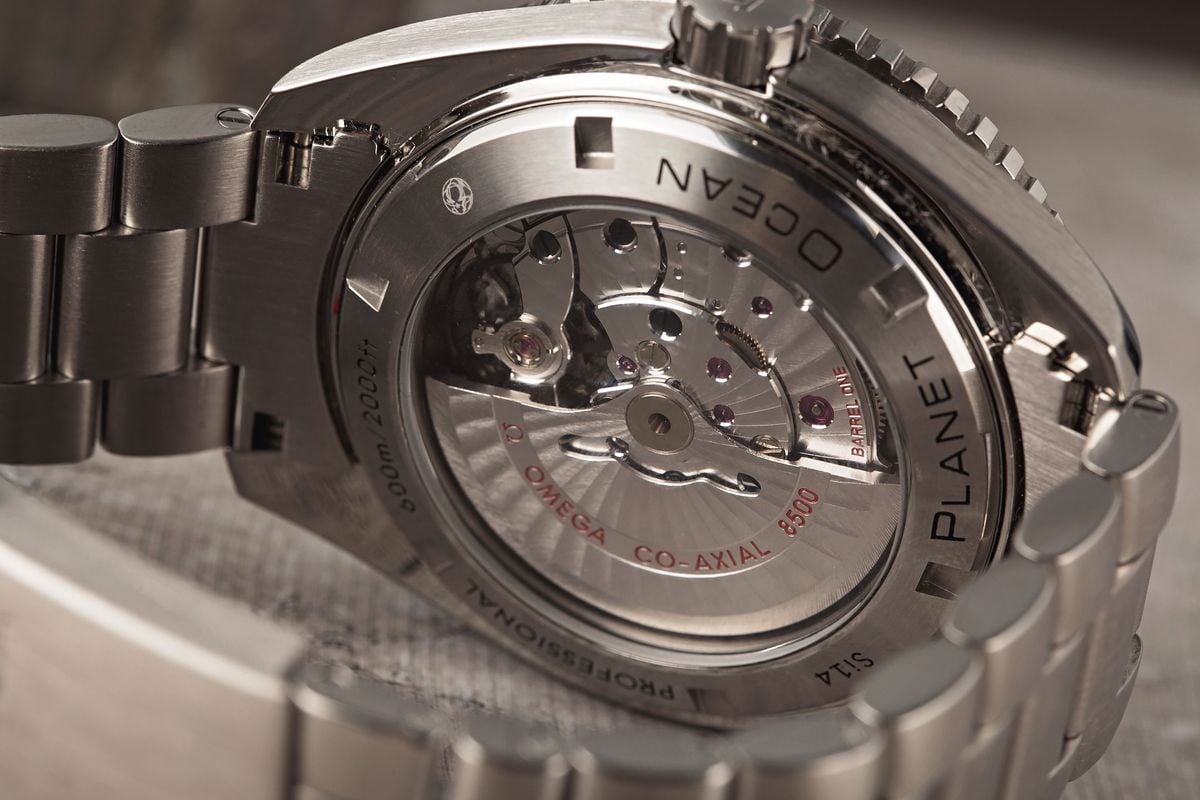
Breitling Superocean Vs. Omega Planet Ocean 600M: Movements
Omega
The Planet Ocean models were among the first watches of the expansive Seamaster range to be given Co-Axial movements. That initial generation used the final version of the Cal. 2500 (an ETA-based engine) which had been slowed down to 25,200vph from 28,800vph, thus creating the optimal frequency for the Co-Axial system.
In 2011, the second iteration of the Planet Ocean collection emerged, now fitted with Omega’s own Cal. 8500 and its variants. While the movement had been in circulation for a while by this point, it was in the Planet Ocean range that it was given its first silicon hairspring and escapement. The current third series has progressed again, now powered (mostly) by the Cal. 8900. This is the Master Chronometer version of the outgoing 8500, meaning it has been certified for precision by METAS, The Federal Institute for Metrology (it was actually the first Omega caliber to win the certification).
The Cal. 8900 is not only accurate to 0/+5 seconds a day, it can also withstand exposure to magnetic fields of more than 15,000 gauss. The collection also uses the Cal. 8800, which is fairly similar except for its smaller physical dimensions and the fact that it has just one mainspring barrel. The Cal. 8900 has two, mounted in series, giving a power reserve of 60-hours, as opposed to the 55-hours of the Cal. 8800. Apart from that, each one has a free-sprung balance, silicon springs, bi-directional winding, and a Co-Axial escapement. The finishing is also superb on both, with Geneva wave patterns on the rotor and bridges, and the engraved legend ‘Omega Master Co-Axial’ to help tell it apart from the older 8500.
As for the chronographs, the steel and titanium variants operate on the Cal. 9900. This, too, is the first Omega chronograph movement to sport a METAS certificate and was brought into the range in 2016. Notable features include a vertical clutch (as on the Rolex Daytona’s Cal. 4130), a column wheel, a titanium balance, and a silicon balance spring. The frequency is back to 28,800vph, despite the Co-Axial escapement, and twin barrels provide a 60-hour power reserve.
There’s no doubt that Omega’s movements are up there with the very best in the industry. However, the Co-Axial calibers do tend to be relatively large, leading to thick cases. The 45.5mm Planet Ocean watches, for instance, measure some 16.5mm – just one thing to be aware of if you tend to wear your shirt sleeves fitted.
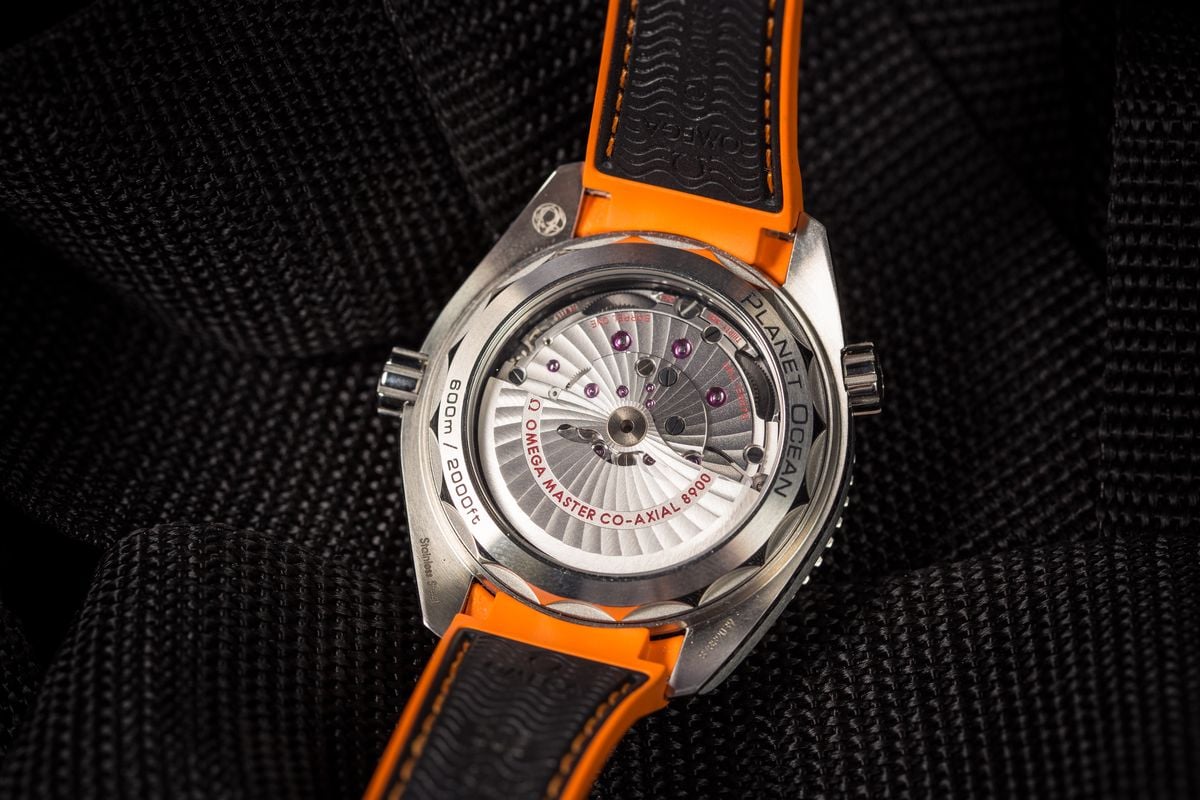
Breitling
As some of the least expensive offerings from Breitling, the Superocean range is powered entirely by modified third party movements. That movement being primarily the Breitling 17, which starts life as the ETA 2824-2. This is the same caliber that was inside the first wave of Superocean Heritage watches before being replaced by the Tudor Cal. MT5612. Whether these regular Superocean models will receive the same treatment remains to be seen.
The ETA 2824-2 is quite possibly the workhorse of all workhorse movements. It has been around since 1982, has been used in literally countless numbers of watches from many different brands, and it is a strong and technically unassuming power plant. It beats at 28,800vph (4Hz) and has a decent 38-hour reserve. It is built in four ‘grades’ – each one differentiated by the quality of their components and their tested accuracy. These are Standard, Elaborated, Top, and Chronometer (the one Breitling fits to the Superocean). To win that grade, the caliber has to be accurate to within -4/+6 seconds a day, across five positions.
The brand is pretty tightlipped over what modifications actually take place to turn the ETA 2824-2 into the Breitling 17, but it is rumored that both the balance spring and mainspring, in addition to the balance wheel and escapement are all swapped out for a variety of higher-performing alternatives. On top of that, selected components are rhodium-plated, and the entire movement will receive a decorative finishing. However, most importantly, they are a watchmaker’s friend. Reliable, simple to work on, and with plenty of easily accessible spare parts, they just keep on ticking, pretty much forever.
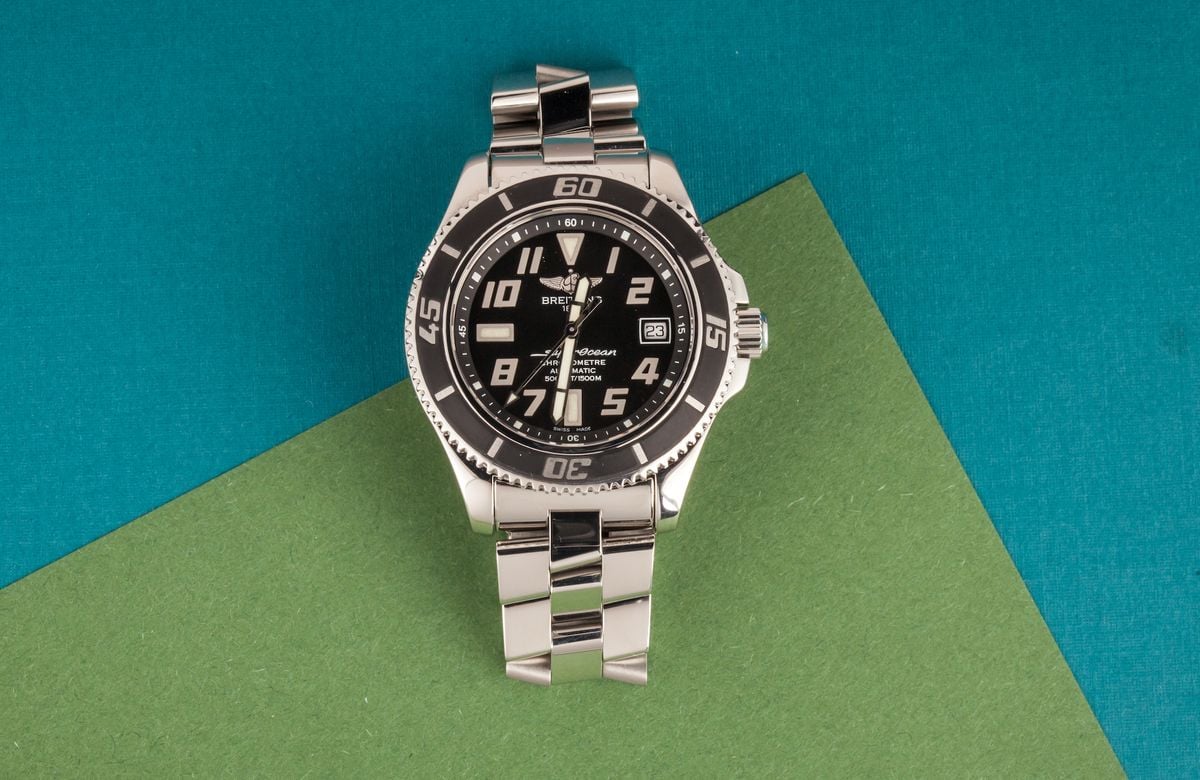
Breitling Superocean Vs. Omega Seamaster Planet Ocean 600M: Final Thoughts
Omega has a far longer history with dive watches than Breitling, as can be seen by the comparative number of models in their respective lineups. The Planet Ocean collection is the flagship range in Omega’s dive arsenal, while the Superocean watches are some of Breitling’s least expensive. The most expensive Superocean actually costs less than the cheapest Planet Ocean.
However, the numbers don’t tell the whole story. Yes, the Breitling Superocean watches may lack some of the finesse of their Omega rivals, but in terms of bang-for-your-buck, they are hard to fault. Furthermore, they are the kind of watches you wouldn’t mind subjecting to the sometimes harsh conditions aboard the average dive boat.
The Omega Planet Ocean watches are obviously a bit more luxurious. Much like similar types of timepieces from other manufacturers such as Rolex and Panerai, it is unlikely that many Planet Ocean watches will ever truly taste any of the planet’s oceans, but that isn’t really the point of them. They are stylish, luxury timepieces that just happen to be highly capable and extremely robust. Both series make a statement, and each has plenty of points in its favor.
